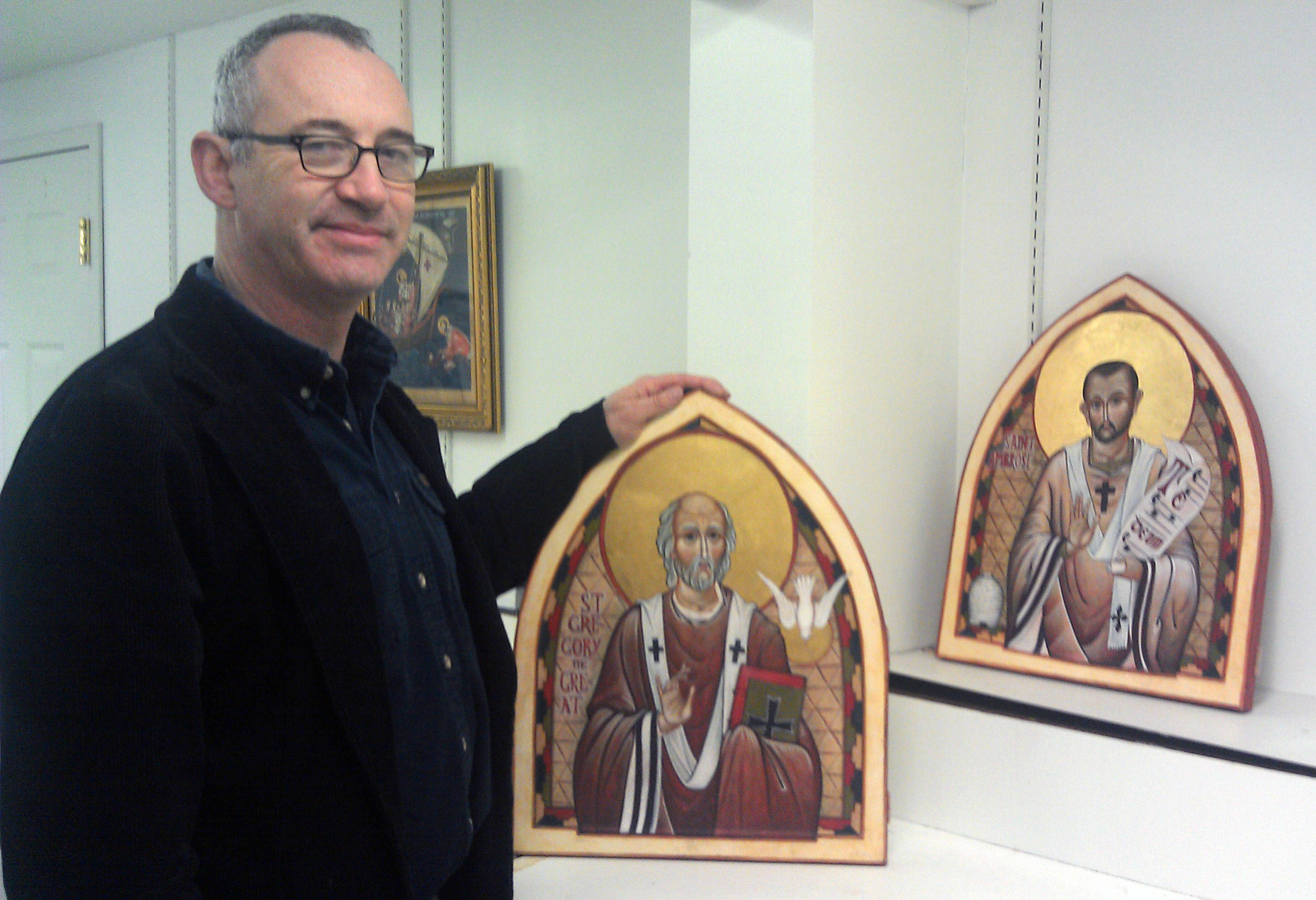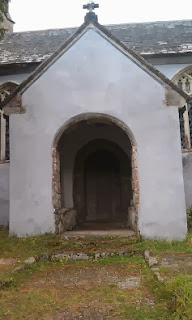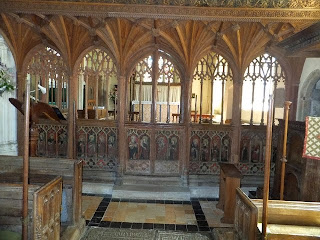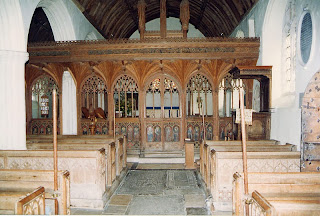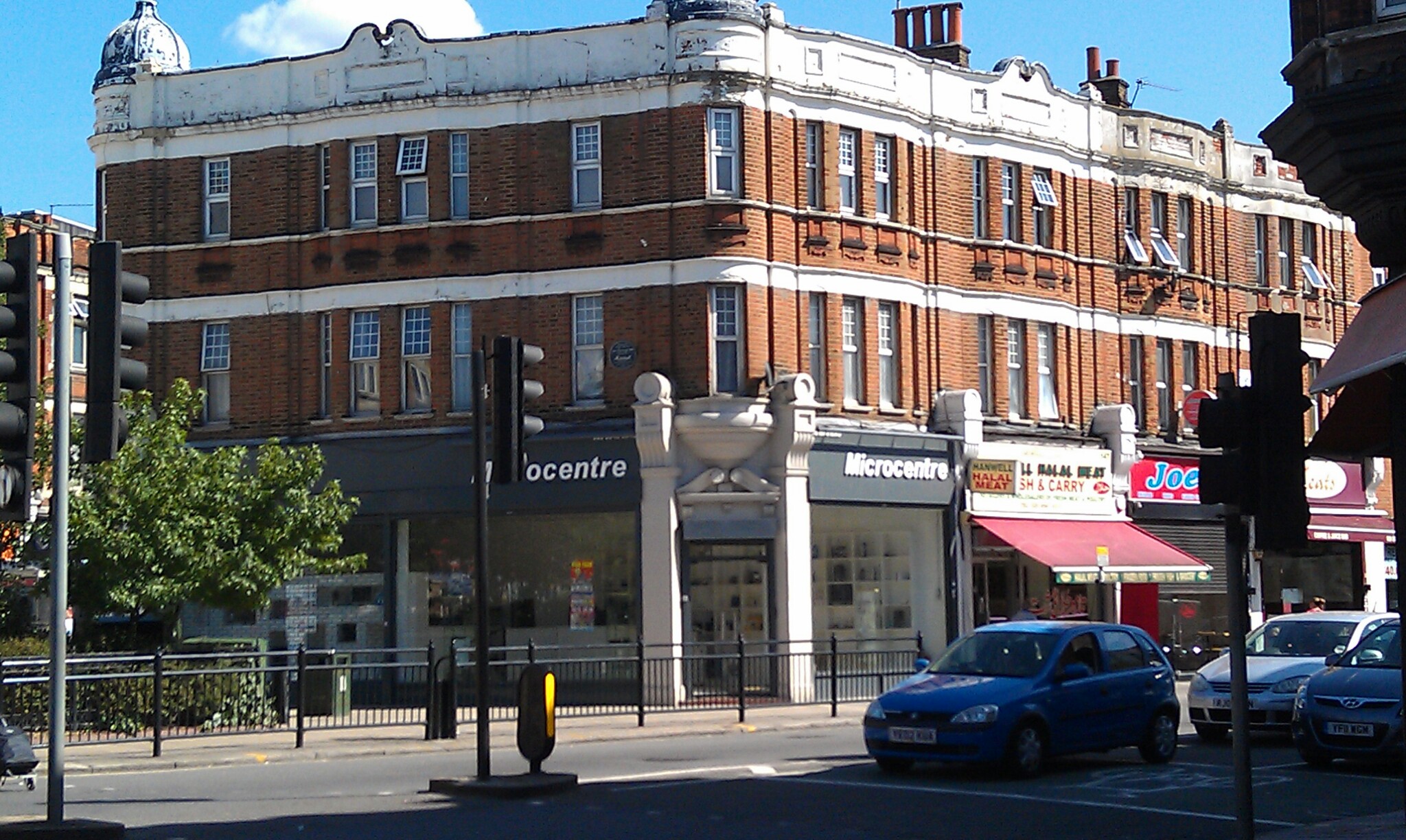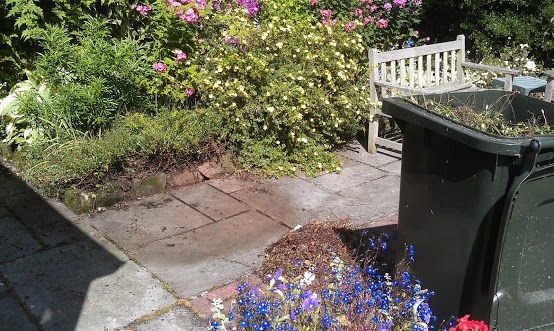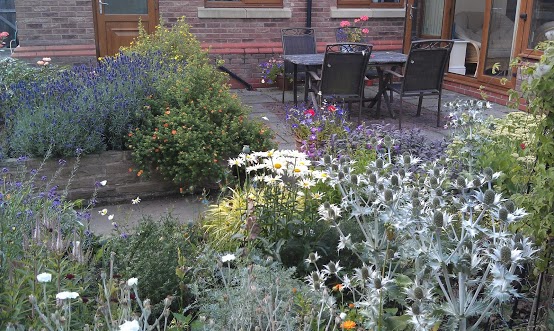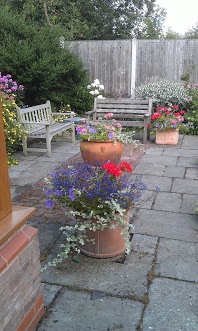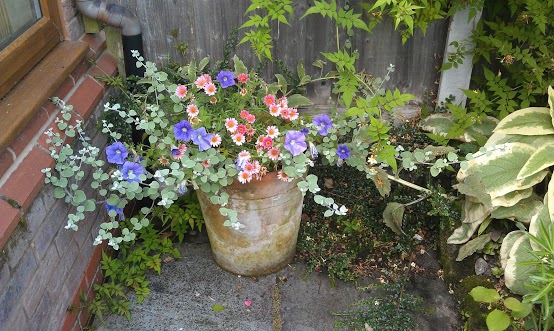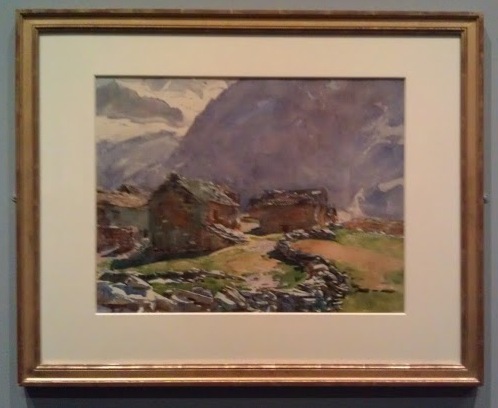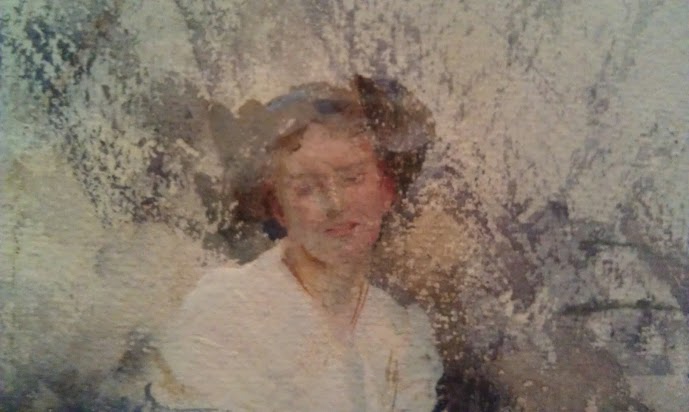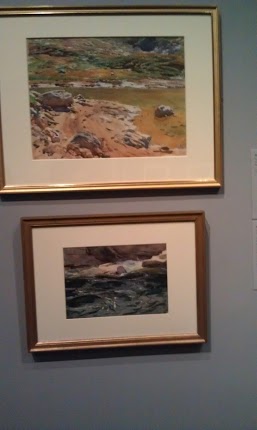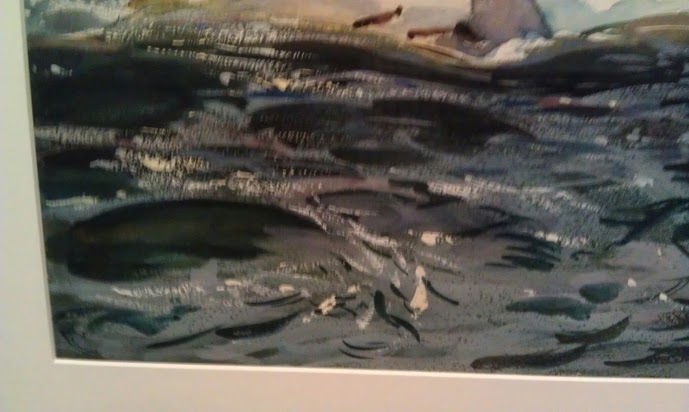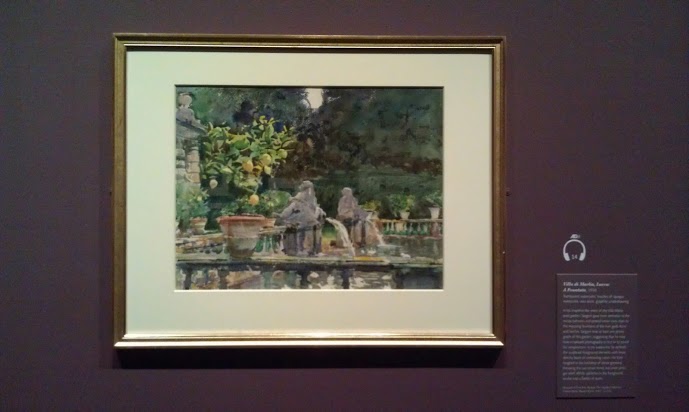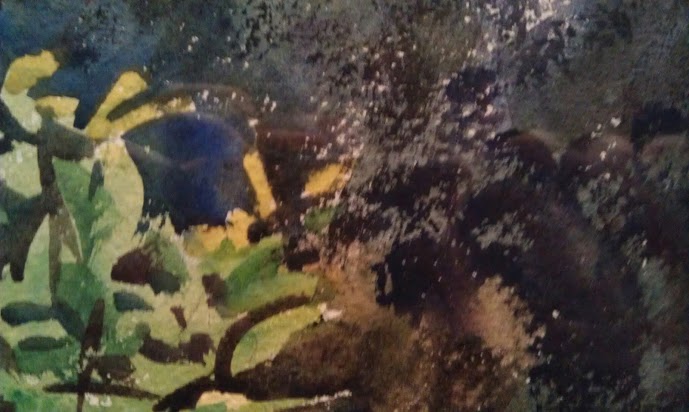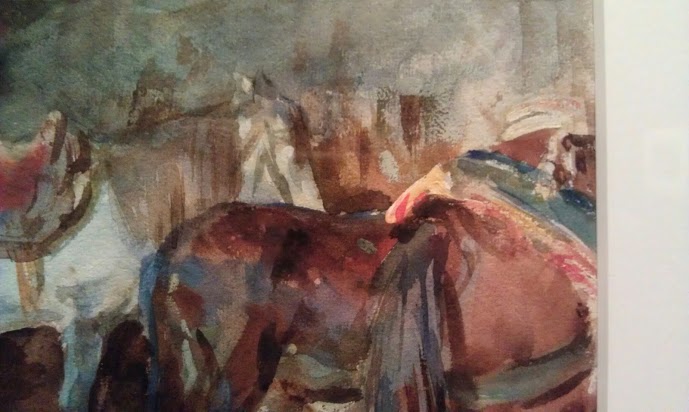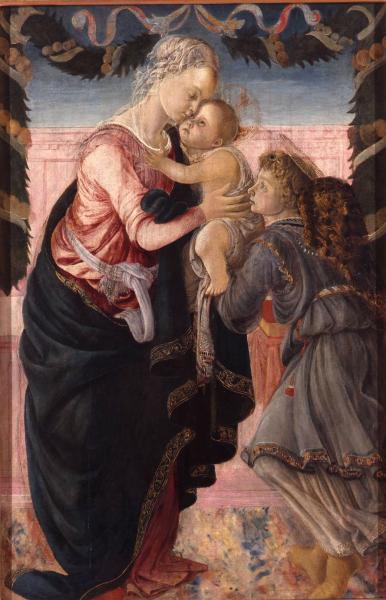St Ambrose - the Second Commission for Our Lady of the Mountains, Jasper, Georgia
 Here is the second completed icon commissioned by Fr Charles Byrd of Our Lady of the Mountains. This is based upon a mosaic in Rome of St Ambrose that was completed in a period very close to when he lived. The beehive is associated with St Ambrose because of his honeyed words - he was an eloquent speaker and the scroll contains the opening words and music to the Te Deum, the liturgical hymn sung in the Office of Readings in the modern Office at every Feast and Sunday which is often attributed to him. St Ambrose wrote many hymns for the liturgy and to the degree that his name became associated with the form. In his Rule, St Benedict refers to the singing of 'Ambrosian' hymns at each office.
This will be close to the other recently completed icon of St Gregory and so is intended to speak to it visually. For this reason I included very similar background and decoration.
Here is the second completed icon commissioned by Fr Charles Byrd of Our Lady of the Mountains. This is based upon a mosaic in Rome of St Ambrose that was completed in a period very close to when he lived. The beehive is associated with St Ambrose because of his honeyed words - he was an eloquent speaker and the scroll contains the opening words and music to the Te Deum, the liturgical hymn sung in the Office of Readings in the modern Office at every Feast and Sunday which is often attributed to him. St Ambrose wrote many hymns for the liturgy and to the degree that his name became associated with the form. In his Rule, St Benedict refers to the singing of 'Ambrosian' hymns at each office.
This will be close to the other recently completed icon of St Gregory and so is intended to speak to it visually. For this reason I included very similar background and decoration.
Below I am in my studio working on its counterpart, St Gregory the Great, and with both in my studio.
Sacred Art Class at TMC
A chance to learn sacred art whatever your level, and to subsidise TMC students so that they can attend for free. I will teach this and it is offered free to Thomas More College students (who have to pay just the standard weekly charge for room and board in the dorm. Even though I am Artist in Residence at the college it is difficult for the students to get intensive tuition. To learn art properly needs blocks of time and this is difficult to organise in the packed timetable during term time. Therefore, I have decided to offer an additional class of four solid days, which will allow them to make some real progress and set them up to work in their own time afterwards. This class is also open to people from outside the college. This is a great chance to learn sacred art and so meet the students of the college as well. We will charge you for this (at what is still a reasonable price for art tuition) as we hope to recoup some of the costs of putting on this class for the students. Please spread the word to those who might be interested in attending or even donating so that this can become a regular feature in the TMC calendar. The cheap hotel rates mentioned in the poster are offered to all those who are connected with this class by the way.
Recently Completed Work - St Gregory the Great
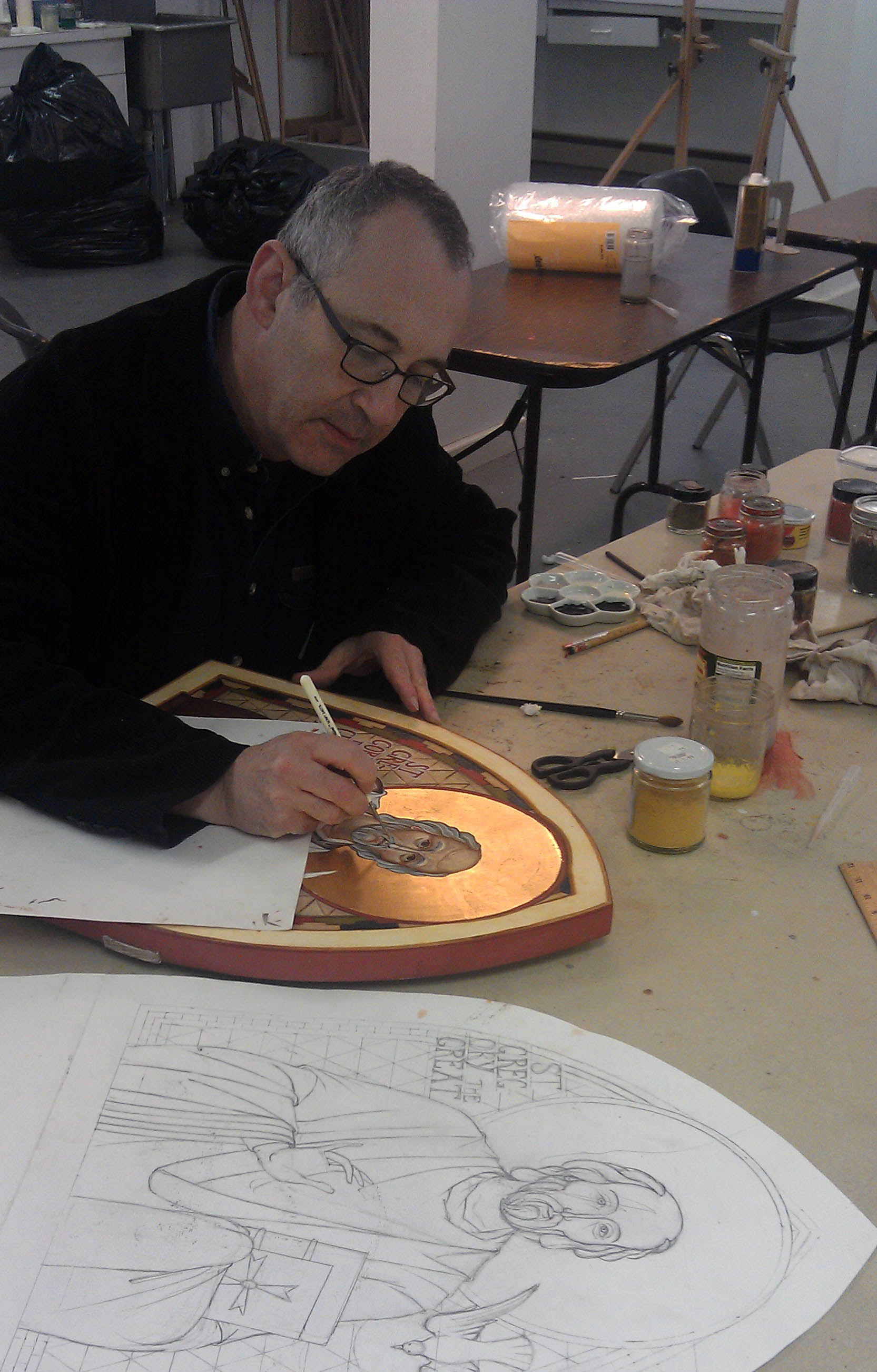 A model lesson in commissioning work I have been busy painting over the last couple of months undertaking a couple of commissions for Fr Charles Byrd of Our Lady of the Mountains Catholic Church in Jasper, Georgia. The first completed is shown here, St Gregory the Great and I will show the other, St Ambrose. This was a great experience from start to finish. First of all, Fr Charles had a clear idea of what he wanted and this was very helpful to me. He had researched what St Gregory would have looked like and did not want a repeat of other icons he had seen because he felt that they would not have been historically accurate. We based this image on a description by a contemporary, John the Deacon and based the vestments upon contemporary icons of other popes. This is why he is not wearing an ornate papal tiara and has long grey hair. For all this, I did not feel at all stifled. He was happy to hear suggestions from me as to how we might fulfill the commission in accord with what he wanted and I feel that the end result is very much a joint effort. I wanted this to have a Western feel and so asked to be able to include the geometric patterning in the border and background. Also I made sure, as always, that we fulfilled the criteria of St Theodore the Studite so that it should be an image worthy of veneration: that it bears the name of the saint; and that it has the characteristics of the person, this refers both to physical traits (such as the grey hair) and those symbols that are associated with him - in this case the dove of the Holy Spirit.
In his Letter to Artists, John Paul II asked for a renewed dialogue between the Church and artists in service of the common good, so that we might move towards reestablishing a culture of beauty. This dialogue can be of the form of grand events, in which the Pope, as Benedict did, gathers together prominent artists to make and address which is then published. This sort of event is the starting point for it puts the need in peoples minds. But a continuation of this, and perhaps the more important and productive part, is the dialogue that takes place at the grassroots. When enlightened patrons and artists who are Catholic and aware of our traditions work together to create art that fulfills its purpose. Whether this has produced a worth result here is for others to say, I hope so. I think the point is that if we are going to have art that serves the Church, it is unlikely that any one person will know all that is necessary and be able to produce the art in any particular case; we need cooperation between enlightened artists, religious who understand Church requirements and the liturgy, and patrons (the people supplying the money are very important and must contribute too).
A model lesson in commissioning work I have been busy painting over the last couple of months undertaking a couple of commissions for Fr Charles Byrd of Our Lady of the Mountains Catholic Church in Jasper, Georgia. The first completed is shown here, St Gregory the Great and I will show the other, St Ambrose. This was a great experience from start to finish. First of all, Fr Charles had a clear idea of what he wanted and this was very helpful to me. He had researched what St Gregory would have looked like and did not want a repeat of other icons he had seen because he felt that they would not have been historically accurate. We based this image on a description by a contemporary, John the Deacon and based the vestments upon contemporary icons of other popes. This is why he is not wearing an ornate papal tiara and has long grey hair. For all this, I did not feel at all stifled. He was happy to hear suggestions from me as to how we might fulfill the commission in accord with what he wanted and I feel that the end result is very much a joint effort. I wanted this to have a Western feel and so asked to be able to include the geometric patterning in the border and background. Also I made sure, as always, that we fulfilled the criteria of St Theodore the Studite so that it should be an image worthy of veneration: that it bears the name of the saint; and that it has the characteristics of the person, this refers both to physical traits (such as the grey hair) and those symbols that are associated with him - in this case the dove of the Holy Spirit.
In his Letter to Artists, John Paul II asked for a renewed dialogue between the Church and artists in service of the common good, so that we might move towards reestablishing a culture of beauty. This dialogue can be of the form of grand events, in which the Pope, as Benedict did, gathers together prominent artists to make and address which is then published. This sort of event is the starting point for it puts the need in peoples minds. But a continuation of this, and perhaps the more important and productive part, is the dialogue that takes place at the grassroots. When enlightened patrons and artists who are Catholic and aware of our traditions work together to create art that fulfills its purpose. Whether this has produced a worth result here is for others to say, I hope so. I think the point is that if we are going to have art that serves the Church, it is unlikely that any one person will know all that is necessary and be able to produce the art in any particular case; we need cooperation between enlightened artists, religious who understand Church requirements and the liturgy, and patrons (the people supplying the money are very important and must contribute too).
They plan on installing this and St Ambrose into the Church in the new year and I hope to see photographs of the ceremony afterwards.
Nativity Scenes in the Snow - New Hampshire Farmers Bearing Witness
 We have had a lot of snow and cold weather recently and I have been feeling cooped up. When we had a relatively warm day (above freezing!) I decided to take advantage and go for a walk in the New Hampshire countryside. I went with my colleague at TMC Ryan Topping and three of his young boys. We headed for one my secret locations in New Hampshire, walking on plowed and sanded dirt roads, so it was firm underfoot. It was just perfect - everywhere looked beautiful and peaceful in the snow, but it was warm enough to outside without discomfort.
I did not expect to see these delightful displays: the large nativity scenes the farmers had created for the advent and Christmas seasons. One was clearly visible from the road and it was clear that the intention was for passers by to see it. The second was set back in the farm, several hundred yards from the road. As we walked past the farmhouse, the farmer came out and introduced himself. He thought we might be associated with the family that had moved into the neighboring farm. He noticed that one of the children who was with us (one of the boys of my colleague at Thomas More, Ryan Topping) was playing with a rosary and told us that he had a pavilion with a statue of Our Lord and Our Lady and we should go and look at it. His grandfather had come down from Quebec in the 1920s and this had been the family farm ever since, he said. They have had to adapt to the times in order to stay economically viable and so as well as continuing with the traditional practice of tapping maple trees and creating the syrup in a sugar shack, they have given the farm over to animals that probably wouldn't have been seen here 100 years ago. They given the pasture over to elk and sell venison to top restaurants and organic markets around the country. The sight of these large, antlered deer seemed all the more appropriate in this Christmas season. It was easy to believe that we were seeing reindeer! I thought that the elk was the North American equivalent of the reindeer but discovered when I got home that that would the caribou. Anyway, its still close enough for me.
We have had a lot of snow and cold weather recently and I have been feeling cooped up. When we had a relatively warm day (above freezing!) I decided to take advantage and go for a walk in the New Hampshire countryside. I went with my colleague at TMC Ryan Topping and three of his young boys. We headed for one my secret locations in New Hampshire, walking on plowed and sanded dirt roads, so it was firm underfoot. It was just perfect - everywhere looked beautiful and peaceful in the snow, but it was warm enough to outside without discomfort.
I did not expect to see these delightful displays: the large nativity scenes the farmers had created for the advent and Christmas seasons. One was clearly visible from the road and it was clear that the intention was for passers by to see it. The second was set back in the farm, several hundred yards from the road. As we walked past the farmhouse, the farmer came out and introduced himself. He thought we might be associated with the family that had moved into the neighboring farm. He noticed that one of the children who was with us (one of the boys of my colleague at Thomas More, Ryan Topping) was playing with a rosary and told us that he had a pavilion with a statue of Our Lord and Our Lady and we should go and look at it. His grandfather had come down from Quebec in the 1920s and this had been the family farm ever since, he said. They have had to adapt to the times in order to stay economically viable and so as well as continuing with the traditional practice of tapping maple trees and creating the syrup in a sugar shack, they have given the farm over to animals that probably wouldn't have been seen here 100 years ago. They given the pasture over to elk and sell venison to top restaurants and organic markets around the country. The sight of these large, antlered deer seemed all the more appropriate in this Christmas season. It was easy to believe that we were seeing reindeer! I thought that the elk was the North American equivalent of the reindeer but discovered when I got home that that would the caribou. Anyway, its still close enough for me.
Thank you to those who made these displays for helping so much to make a great day out.
Photos below show first the nativity scene on the roadside; and the pavilion set back in the fields with the Sacred Heart of Jesus the central figure.
... and then look back towards the farmhouse:
How to Pray With Visual Imagery
It is now more than three and a half years since I started this blog so first of all I would like to thank so many of you for your interest and your comments. I am currently involved in several book projects which will be published in the early part of next year - more information to come. In order to give myself time to write these, I thought I would reduce my postings to one fresh piece per week. However, it also occurred to me that many of you who read this, will not have seen much of what I posted in the first two years. In my mind, these are foundational to my thinking and shed light on much of what I write now, so I thought they would be worth repeating. So for these two reasons I thought I would replay some of these foundational posts. So for the next couple of months, I will alternate old and new. The first replay was first published in April, 2010:
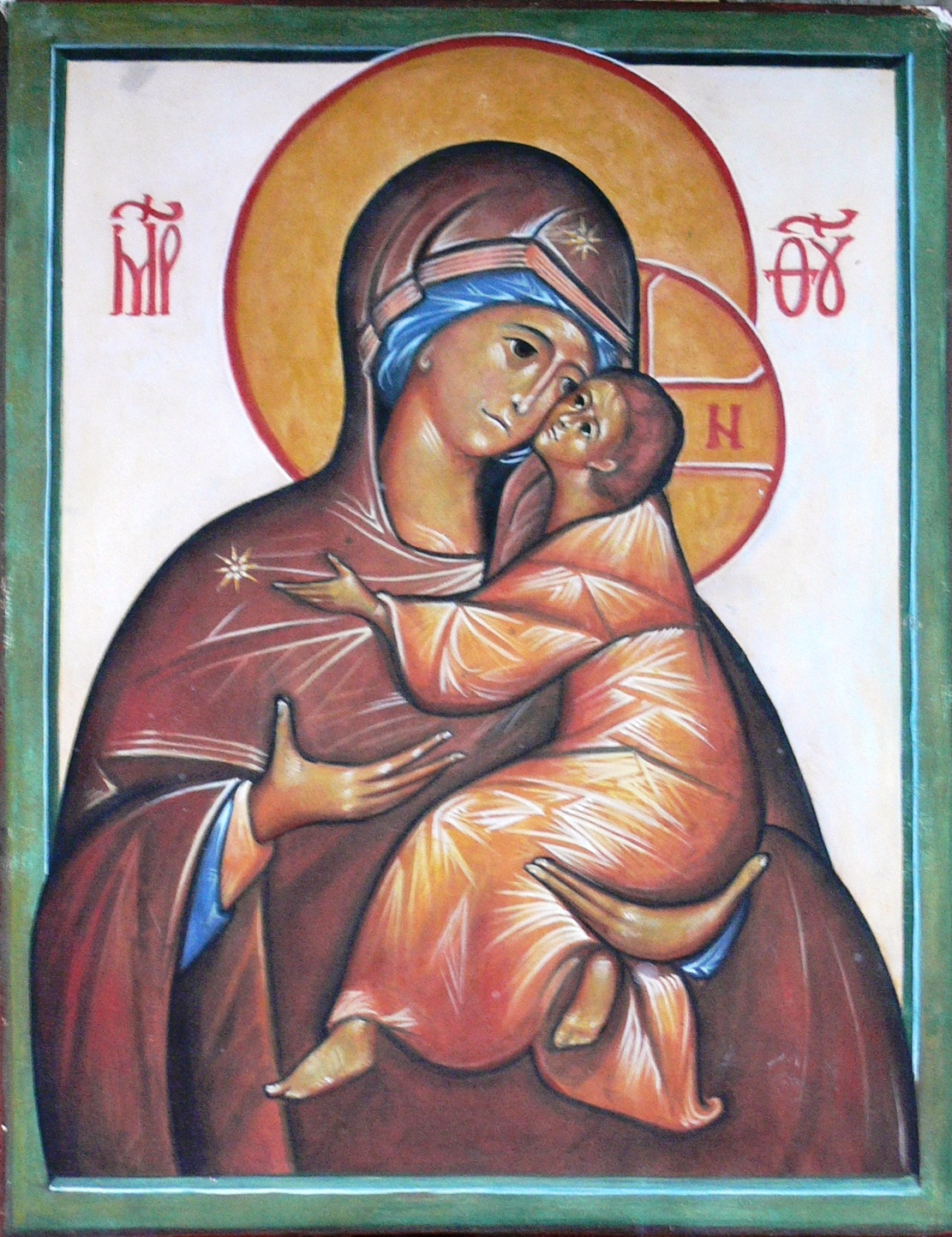 When I first started painting icons I was, of course, interested in knowing as well how they related to prayer. I was referred by others (though not my icon painting teacher) to books that were intended as instruction manuals in visual prayer. I read a couple and perhaps I chose badly, but I struggled with them. One the one hand, they seemed to be suggesting some sort of meditative process in which one spent long quiet periods staring at an icon and experiencing it, so to speak, allowing thoughts and feelings to occur to me. Being by nature an Englishman of the stiff-upper-lip temperament (and happy to be so) I was suspicious of this. I had finally found a traditional method of teaching art that didn’t rely on splashing my emotions on paper, and here I was being told that in the end, the art I was learning to produce was in fact intended to speak to us through a heightened language of emotion. Furthermore, the language used to articulate the methods always seemed to employ what struck me as pseudo-mystical expressions and which, I suspected, were being used to hide the fact that they weren’t really saying very much.
When I first started painting icons I was, of course, interested in knowing as well how they related to prayer. I was referred by others (though not my icon painting teacher) to books that were intended as instruction manuals in visual prayer. I read a couple and perhaps I chose badly, but I struggled with them. One the one hand, they seemed to be suggesting some sort of meditative process in which one spent long quiet periods staring at an icon and experiencing it, so to speak, allowing thoughts and feelings to occur to me. Being by nature an Englishman of the stiff-upper-lip temperament (and happy to be so) I was suspicious of this. I had finally found a traditional method of teaching art that didn’t rely on splashing my emotions on paper, and here I was being told that in the end, the art I was learning to produce was in fact intended to speak to us through a heightened language of emotion. Furthermore, the language used to articulate the methods always seemed to employ what struck me as pseudo-mystical expressions and which, I suspected, were being used to hide the fact that they weren’t really saying very much.
So I started to ask my teacher about this and to observe Eastern Christians praying with icons. What struck me was that prayer for them seemed to be pretty much what prayer was for me. They said prayers that contained the sentiments that they wished to express to God. The difference between what they did and what I did at that time was that they turned and looked at an icon as they prayed. Also, when at home, often happily and without embarrassment they sang their prayers using very simple, easily learnt chant. Before meals, for example, the family would stand up, face an icon of Christ on the wall and sing a prayer of gratitude or even just the Our Father.
As I learnt more about icons through learning to paint them, I realized that every aspect of the style of an icon is worked out to engage us in a dynamic that assists prayer – through its form and content the icon will do the work of directing our thoughts to heaven. In short I don’t need to ‘do’ anything. The icon does the work for me.
The iconographic form is not the only one to do this. The Western Catholic tradition is very rich and has also the Baroque and gothic art forms that are carefully worked out to engage the observer in a dynamic of prayer, although in different ways. If the icon draws our thoughts to heaven, the baroque form is designed in contrast to have an impact at a distance in order to make God present on earth. The gothic figurative art is the art of pilgrimage, or of transition from earth to heaven, and stylistically it sits between the iconographic and baroque. It is the ‘gradual psalm’ of artistic form. Just like the spires of its architecture, it spans the gap between heaven and earth so that we have a sense both of where we going to and where we are coming from. I will discuss how the form of each tradition achieves in the next articles I write.
So the advice I was given was to ditch the books about praying with icons, and learn first to pray. Then as I pray always aim to have visual imagery that I allow to engage my sight and which assists. St Augustine said that those who sing their prayers pray twice. I would add that those who look at visual imagery as well pray three times (and if we use incense four times, and consider posture five). This process of engaging different aspects of the person in addition to the intellect is a move towards the ideal of praying with the whole person. This is what praying from the heart means. The heart is the vector sum of our thoughts and actions. It is our human centre of gravity when both body and soul are considered. It is the single point that, when everything is taken into account, defines what I am doing. It is the heart of us, in the sense of representing the core. This is why it is a symbol of the person. It is a symbol of love also because each of us is made by God to love him and our fellow man. It symbolizes what we ought to be rather than, necessarily, what we are. The modern world has distorted the symbolism of the heart into one of desire and ‘heartfelt’ emotion, precisely because these are the qualities that so many today associate with the essence of humanity.
The liturgy is ultimate form of prayer. By praying with the Church, the mystical body of Christ, we are participating in ‘Christ's own prayer addressed to the Father in the Holy Spirit. In the liturgy, all Christian prayer finds its source and goal.’[1] Therefore, the most important practice of praying with visual imagery is in the context of the liturgy. For example, when we pray to the Father then we look at Christ, for those who have seen Him have seen the Father. The three Catholic figurative traditions in art already mentioned were developed specifically to assist this process.
Just as the liturgy is the ‘source and goal’ of prayer, so liturgical art is, I would argue, the source and goal of all Catholic art. The forms that are united to the liturgy are the basis of Catholic culture. All truly Catholic art will participate in these forms and so even if a landscape in the sitting room, will point us to the liturgical. We cannot become a culture of beauty until we habitually engage in the full human experience of the liturgy. In the context of visual art, this practice will be the source of grace from which artists will be able to produce art that will be the basis of the culture of beauty; the source of grace and from which patrons will know what art to commission; and in turn by which all of us will be able to fulfill our vocation, whatever it may be, by travelling on the via pulchritudinis, the Way of Beauty, recently described by Pope Benedict XVI.
Of course, each individual (depending upon his purse) usually has a limited influence on what art we see in our churches. However, as lay people, we can pray the Liturgy of the Hours and control imagery that we use. The tradition of the prayer corner, in which paintings are placed on a small table or shelf at home as a focus of prayer, is a good one to adopt. We ‘orientate’ our prayer towards this, letting the imagery engage our sight as we do so. We can also sing, use incense and stand, bow, sit or kneel as appropriate while praying. A book I found useful in this regard, which describes traditional practices is called Earthen Vessels (The Practice of Personal Prayer According to the Patristic Tradition) by Gabriel Bunge, OSB
Does this mean that meditation of visual imagery is not appropriate? No it does not. But as with all prayer that is not liturgical, it is should be understood by its relation to the liturgy. So just as lectio divina, for example, is good in that it is ordered to the liturgy because through it our participation in the liturgy is deepened and intensified. So, perhaps, should meditation upon visual imagery should be understood in relation to the use of imagery in the liturgical context. Also, I would say that it is useful, just as with lectio, to avoid the confusion between the Western and Eastern non-Christian ideas of meditation and contemplation are. I was recommended a book recently that helped me greatly in this regard. It is called Praying Scripture for a Change – An Introduction to Lectio Divina by Dr Tim Gray.
[1] CCC, 1073
A Pretty 19th Century Church in Vermont
 I recently spent some time on holiday in a state adjoining New Hampshire, Vermont. We were staying close to at town called Killington (when the deep snow arrives it is a ski resort). Nearby, as we drove home, we saw a hamlet which consisted of an early 19th century stone church and connected buildings. We pulled over and took some quick photographs.
Called the Episcopalian Church of Our Saviour, it is in a Romanesque style but is of its time too (think of Pope Francis and Evangelii Gaudium). Once again, I think it shows what we could do today if we wished to, by respect the past and build on past traditions and 'building on them'. The pitched roof is perfect for the snowy Vermont winters.
I recently spent some time on holiday in a state adjoining New Hampshire, Vermont. We were staying close to at town called Killington (when the deep snow arrives it is a ski resort). Nearby, as we drove home, we saw a hamlet which consisted of an early 19th century stone church and connected buildings. We pulled over and took some quick photographs.
Called the Episcopalian Church of Our Saviour, it is in a Romanesque style but is of its time too (think of Pope Francis and Evangelii Gaudium). Once again, I think it shows what we could do today if we wished to, by respect the past and build on past traditions and 'building on them'. The pitched roof is perfect for the snowy Vermont winters.
I will let the photographs speak for themselves:
Evangelii Gaudium - Pope Francis talks of the Way of Beauty
This is the first short article in which I offer some reaction to the apostolic exhortation Evangelii Gaudium of Pope Francis. In this he referred directly to Pope Benedict's phrase, the 'via pulchritudinis' as a vital component in evangelisation and of the importance of the arts.
'167. Every form of catechesis would do well to attend to the “way of beauty” (via pulchritudinis). Proclaiming Christ means showing that to believe in and to follow him is not only something right and true, but also something beautiful, capable of filling life with new splendour and profound joy, even in the midst of difficulties. Every expression of true beauty can thus be acknowledged as a path leading to an encounter with the Lord Jesus. This has nothing to do with fostering an aesthetic relativism which would downplay the inseparable bond between truth, goodness and beauty, but rather a renewed esteem for beauty as a means of touching the human heart and enabling the truth and goodness of the Risen Christ to radiate within it. If, as Saint Augustine says, we love only that which is beautiful, the incarnate Son, as the revelation of infinite beauty, is supremely lovable and draws us to himself with bonds of love. So a formation in the via pulchritudinis ought to be part of our effort to pass on the faith. Each particular Church should encourage the use of the arts in evangelization, building on the treasures of the past but also drawing upon the wide variety of contemporary expressions so as to transmit the faith in a new “language of parables”. We must be bold enough to discover new signs and new symbols, new flesh to embody and communicate the word, and different forms of beauty which are valued in different cultural settings, including those unconventional modes of beauty which may mean little to the evangelizers, yet prove particularly attractive for others.'
So he stresses the objectivity of beauty and how that which is genuinely beautiful points to God. In regard to art in particular he stresses the importance of creating new forms but that this should be done by 'building on the treasures of the past'. This means, as I read it, doing what Christian artists have always done: looking at the forms of the cultures of those with whom they wish to communicate with, in a discerning way; deciding what is consistent with the principle of objective beauty (and here we look to traditions to guide us) and then applying them in the context of those Catholic traditions (and, incidentally, exactly what happened after the Council of Trent as part of the Catholic Counter-Reformation).
This is very different from what those who reject tradition might wish to do - simply incorporating modern forms without any regard to those of the past and assuming that by making the content Christian we have something that is good. To my mind the Holy Father is absolutely right and it is consistent, for example, with what Pius XII said in Mediator Dei in regard to figurative art; and in general to the writing of Popes Paul VI, John Paul II and Benedict XVI on such matters.
Given that this constitutes a small part of the whole document, one might think that he does not give it great importance. However, his reiteration of the writing past recent Popes, suggests that one should read this document not as an isolated statement that replaces previous ideas, but in the context of a much larger corpus - as one that re-emphasises, builds on and adds to, albeit incrementally, what came before.
Also, given that the document is an apostolic exhortation following a synod, one wonders how much we should look at this as a personal statement of the Pope, and how much it is in fact an account of contributions made by others. I am not expert enough to answer that question. Except to say that much of it reads to me like the section on art does - the restatement of things said before without any attempt to give new insights: it is simply giving the message, 'this is still important'.
How the Ancient Sarum Rite Formed the Art and Architecture of a Tiny Country Church in Devon, England
 Here are some photos of a tiny church in Devon. The tour of the church was given to myself and the rest of the class on the Maryvale's Art Beauty and Inspiration course that was taking place at Buckfast Abbey in Devon. As part of this, we asked Michael Vian Clark, who taught chant to the monks at the abbey, and who is a keen local historian to talk to us about one of the local churches. He is now based in Rome where has has recently begun his studies as a seminarian (for the Diocese of Plymouth). Michael is a keen student of the Sarum Rite and chanted for us in the church (teaching us to accompany him with an organum drone) as he explained how this was the music that would have resonated throughout this church prior to the reformation.
Here are some photos of a tiny church in Devon. The tour of the church was given to myself and the rest of the class on the Maryvale's Art Beauty and Inspiration course that was taking place at Buckfast Abbey in Devon. As part of this, we asked Michael Vian Clark, who taught chant to the monks at the abbey, and who is a keen local historian to talk to us about one of the local churches. He is now based in Rome where has has recently begun his studies as a seminarian (for the Diocese of Plymouth). Michael is a keen student of the Sarum Rite and chanted for us in the church (teaching us to accompany him with an organum drone) as he explained how this was the music that would have resonated throughout this church prior to the reformation.
Michael has written a description for NLM readers, which I give below. There are some aspects of this that particularly strike me. When Fr Lang of the London Oratory spoke about church architecture this summer at Sacra Liturgia 2013 in Rome, he stressed the importance of thresholds that clearly separate the temple, the place of worship from the outside world. The porch or the cloister, in grander churches, become especially important in this respect in churches that are designed for the Sarum Rite. This rite has many processions that emphasise the earthly pilgrimage from the City of Man to the City of God. This point of pilgrimage by which even in this life we can by degrees be transformed and participate in the divine nature through participation in the sacred liturgy, is a feature of gothic art, which stylistically spans the divide between the shadowy fallen world of the baroque; and the heavenly state of eschatological man as revealed by the icon. As Jean Corbon describes in his book the Wellspring of Worship, by being part of the mystical body of Christ, his Church, we can participate in the transfigured Light.
A book has recently been published that looks at the design of Salisbury Cathedral in the 13th Century, here, relating to the regular processions that took place. We see similar influences even in this little country church and its humble porch. As Michael puts it:: 'The porch had particular significance in the Ritual of the Use of Sarum, which involved more regular processions outside of the Church building than other expressions of the Roman Rite. Indeed there were exceptional processions on Feasts such as Candlemas, Palm Sunday, Easter, Ascension, Pentecost, Corpus Christi and Rogation Days which included a station outside at the 'Palm Cross' - a stone structure in the churchyard with ascending steps. Here at Ashton the base of the Palm Cross is still visible, directly opposite the porch with its image niche above the main portal. The porch was the place where the Rite of Baptism, Holy Matrimony and the Churching of Women actually began - the books describe the location ante ostium Ecclesiae. The threshold of the Church was therefore more than mere weatherproofing. It had its own liturgical function.'
These painting probably survived because the church is so remote and there would have been strong local sentiment to keep them. There is a pale fresco on the wall which was revealed when a painting that had previously hung on that section of the wall for centuries was removed.
What we see here is an indication of just how colourful and ornate even a small country church would have been during the period when this gothic church, in the English perpendicular style, though very simplified, was built. There is an ornate rude screen. The floor, which immediately caught my eye because of its geometric patterned form is probably a Victorian renovation, Michael told me.
Here are some thoughts that Michael has put down for us in connection with this church:
''The Church of St John the Baptist is dramatically situated on a rocky outcrop overlooking the Teign Valley in Devon, England. It was, and still is, quite remote: accessible only by high-sided lanes. It is part of a family of churches in this valley that share similar architectural features: one may reasonably speculate the hand of the same masons, carpenters and glass painters.
'Like so many Devonian churches, the details (that is to say the window tracery, screenwork and fragments of painted glass) are generally of the late fourteenth to early fifteenth century, but at Ashton, as elsewhere, this disguises much more ancient fabric into which such details were inserted as part of a widespread programme of enhancement and beautification of liturgical spaces right up to the Reformation. The most striking addition to the typical dual-cell structure of a post-Conquest church is the North aisle, separate by slender and elegant Beer stone arcades that may derive inspiration from the late thirteenth century design of Exeter Cathedral. This aisle was built to house a secondary altar, the sanctuary of which later became the 'family pew' of the Chudleigh family, giving a strong clue as to its original benefactors.
'Later, a porch was also added - a feature that had particular significance in the Ritual of the Use of Sarum, [as mentioned]. The glory of Ashton is no doubt the beautifully preserved Rood Screen and Parclose Screen that respectively separate Nave from Chancel and the two altars one from the other. Rood Screens were a particularly favoured devotional expression in England as a consequence of the division of legal responsibility for the Church fabric itself: Chancels were the responsibility of the Living whereas Naves were the responsibility of the Parish.
'The Rood Screen marked the boundary and parishes are known to have been anxious to ensure their screen and Rood were as impressive as possible (and more impressive than their neighbours.) Typically a Screen has three components: a Dado with images of the Saints; Tracery work that permits a view of the High Altar and above this a Loft which gave access to the Rood itself (composed of a large image of the Crucified Lord flanked either side by His Mother and the Beloved Disciple) which was the dominating feature of the people's part of the Church.
'At Ashton the Screen was sensitively restored by Harry Hems of Exeter in the early twentieth century and the Rood itself has been restored, albeit in unpainted wood. The image sequence is a mixture of the local and universal and sometimes grouped in logical sequence - e.g. Doctors, Evangelists, Martyrs, Holy Helpers; sometimes not. An interesting feature is that of local saint, Sativola or Sidwell who features with the scythe of her martyrdom both on the screen and in glass at Ashton, demonstrating the strength of her cult in the former diocese of Exeter. The connections with mainstream (and very Roman) Catholicism are also clear: here are depicted Popes, Cardinals, Bishops and international saints, such as Zita of Lucca and Anthony of Egypt as well as saints such as Ursula and, possibly Thomas of Canterbury and Boniface that connected Britain with Continental Europe.
'Admittedly the quality of the artistry is not especially high - note that the faces of the saints are essentially the same, however this Screen has even more to reveal. Perhaps the most interesting feature is the sequence of catechetical paintings on the reverse of the Screen in the Chudleigh chapel (which survive) and the Sanctuary (which are faint outlines only) which seem to have been added later. The panels of the Annunciation and Visitation are conventional enough, but texts for the Transfiguration (a later Feast for the Universal Church) demonstrate a dynamic concern to keep up to date liturgically, even in this remote corner of Devon. Other features of note include a rather faded but nonetheless striking figure of the Lord showing his wounds, after the manner of the Mass of St Gregory. Unlike the extant Sculpture of the same theme in Exeter Cathedral, here this does not form a reredos, but is instead a devotional painting. Fragments of glass, including figure painting of exceptionally high quality survives in the North aisle, notably the figure of St Sidwell mentioned above and St Gabriel holding a scroll bearing the text of the Annunciation. In summary, this is a remarkable Church not only for the survival of the liturgical apparatus of the Use of Sarum, but also for the quality of the workmanship on display. A Church worth a detour of many miles to see.''
In this view down the ailse, the second altar Michael refers to is just barely visible to the left, we seen the section inside that portion of the screen later on.
This is the area at the front of the church that contains the second altar.
The fresco below was revealed when a more recent wall hanging was removed.
Audio of Talk Given In New York City: the Formation of the Catholic Artist
A training in skills, humility and beauty, which would be useful to all For any who are interested, here is a recording of a talk I gave in New York City recently. It is about the formation of the Catholic artist. The link is here. As I describe in the talk, this training aims not only to impart the technical skills necessary, but also forms the person in humility so that his instincts are to follow inspiration (should God choose to inspire him); and gives a formation in beauty that develops the artists intuitive sense of right relationship and harmony. It is a liturgical centered training so those aspects that form the person are not trained so much as given; in that they are the fruits of full and active participation in the liturgy. As such this training, therefore, is useful too (with minimal adaption) anybody, regardless of his personal vocation.
I should say that I was very impressed with my hosts, the Catholic Artists' Society in their emphasis on the importance of the spiritual life of the artist and its integration with his art. After the talk, Compline was sung in the chapel and all were encouraged to stay and pray. Before it the Hour began, we were given the text and simple musical score and the leader explained to those who might not have any experience what we were about to do, stressed the value of the Liturgy of the Hours and explained to us how to sing. It worked very well. I loved the way that they encouraged people to take the handouts home and think about making this part of the prayer life of the domestic church.
The link for the audio is here. (www.catholicartistssociety.org/david-claytons-lecture-forming-the-artist/)
The next event in this series is on December 14th and is a lecture by Alice Ramos of St Johns University.
An Ordinary Street in the London Suburb of Hanwell
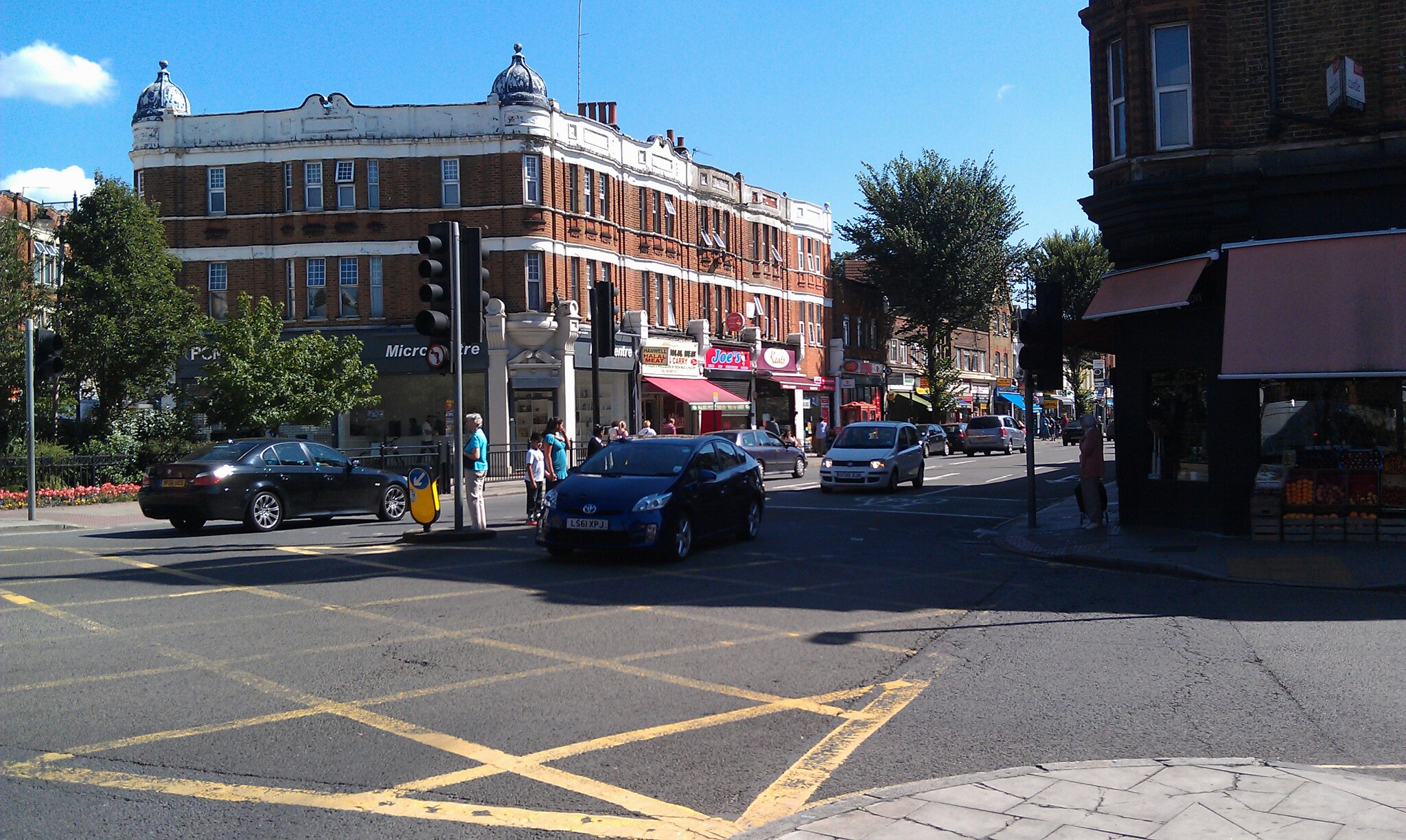 After the last view of Nashua, NH mainstreet here are some views of Hanwell in west London. They were taken over the summer when I was on my way to Heathrow airport.
When I teach the class on harmony and proportion in architect at Thomas More College, we do study the traditional principles as manifested in the great buildings of the past, but I am as anxious to establish in the idea also that this is not just something for cathedrals and grand civic buildings. Even the buildings that we use in everyday life - affordable mass housing, the shops, offices, businesses and factories can conform to these simple principles and create a beautiful and livable environment. I believe that cities are where most of us are meant to live - the future is not, and nor ought to be, one of a new high-tech agrarianism. However, I do not believe that modern cities need be the inhuman places that we tend to think is inevitable. This is where the consideration of the beauty of ordinary things and places becomes so important.
After the last view of Nashua, NH mainstreet here are some views of Hanwell in west London. They were taken over the summer when I was on my way to Heathrow airport.
When I teach the class on harmony and proportion in architect at Thomas More College, we do study the traditional principles as manifested in the great buildings of the past, but I am as anxious to establish in the idea also that this is not just something for cathedrals and grand civic buildings. Even the buildings that we use in everyday life - affordable mass housing, the shops, offices, businesses and factories can conform to these simple principles and create a beautiful and livable environment. I believe that cities are where most of us are meant to live - the future is not, and nor ought to be, one of a new high-tech agrarianism. However, I do not believe that modern cities need be the inhuman places that we tend to think is inevitable. This is where the consideration of the beauty of ordinary things and places becomes so important.
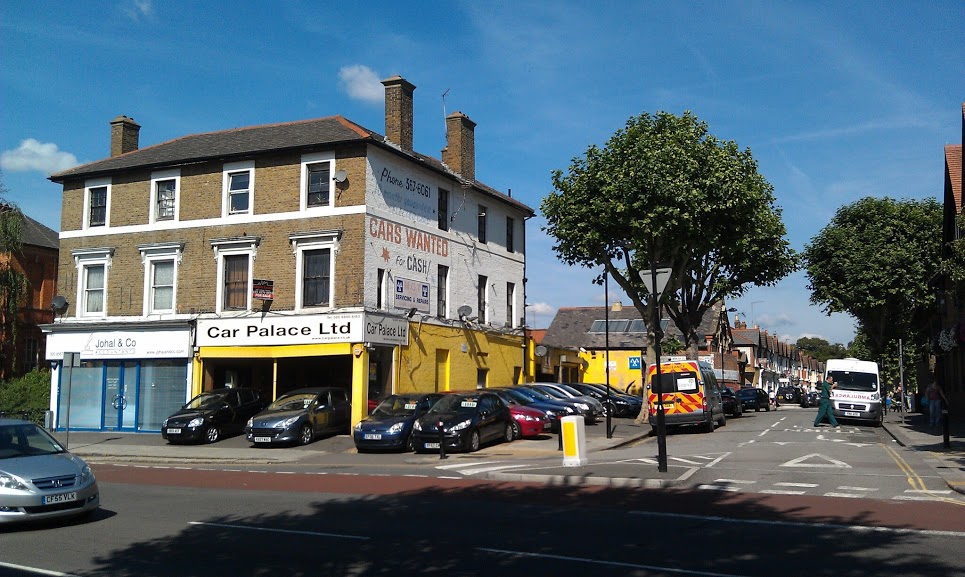 I stopped at a roadside cafe for an English breakfast on my to catch my plane home and it was a sunny morning. What was interesting to note was that the basic structures of the all the buildings conformed to traditional harmonious proportions. I am guessing they were built around the turn of the last century. As you look at each one you can see the triple layered proportion with each storey a different size in the traditional manner. These were never grand buildings, just ordinary high street buildings built for every day use. Even though the modern businesses that occupy them have made no attempt to accentuate or conform to the harmonious proportions in their modifications, what remains still makes Hanwell High Street nice enough for the Big Bites Cafe to put tables outside so that patrons could enjoy the sunshine. I would always maintain that if they knew it, they would attract even more business if only they would take this into account. The beautification of the high street is one of the main ways that towns seek to preserve the town centres and fight against the out-of-town malls to maintain a community feel. This is known, but rarely is this aspect of how it might be done understood.
I stopped at a roadside cafe for an English breakfast on my to catch my plane home and it was a sunny morning. What was interesting to note was that the basic structures of the all the buildings conformed to traditional harmonious proportions. I am guessing they were built around the turn of the last century. As you look at each one you can see the triple layered proportion with each storey a different size in the traditional manner. These were never grand buildings, just ordinary high street buildings built for every day use. Even though the modern businesses that occupy them have made no attempt to accentuate or conform to the harmonious proportions in their modifications, what remains still makes Hanwell High Street nice enough for the Big Bites Cafe to put tables outside so that patrons could enjoy the sunshine. I would always maintain that if they knew it, they would attract even more business if only they would take this into account. The beautification of the high street is one of the main ways that towns seek to preserve the town centres and fight against the out-of-town malls to maintain a community feel. This is known, but rarely is this aspect of how it might be done understood.
For the curious I have included a photo of the menu, I chose the Tradition English complete with B. Pudding, ie Black Pudding...ah how I miss England.
The Old Library, Nashua, New Hampshire and the Richmond Court Apartments, Brookline, Massachusetts
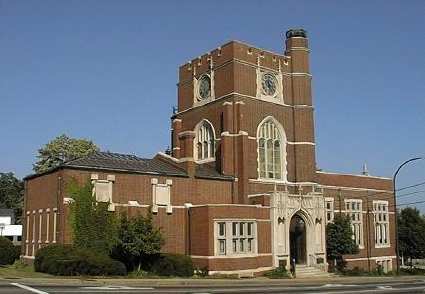 Here are two building designed by the same American architect, Ralph Adams Cram.
Nashua, New Hampshire is the town I live in. Most days I drive past the old library - the Hunt Memorial Library - and always notice the proportions of its design. I am teaching a class at Thomas More College (which is in nearby Merrimack, NH) at the moment on traditional ideas of harmonious proportion and how they have been used (or ignored) in architecture over the centuries from ancient Greece up to the present day. We are studying original architectural sources such as the Roman architect, Vitruvius; and Alberti from the High Renaissance; and writings on proportion and harmony that influenced architecture such as De Musica and De Arithmetica by Boethius. As an exercise, we will take a walk down the main street of Nashua and consider how these shops, banks and offices incorporate proportion, or not. the main street is a mixture of late 19th century and early 20th century, where architects use traditional proportion in some way; and more recent where it is ignored. I am trying to train the students to be able to recognise and will challenge them to consider how those modern buildings might be improved by the addition of proportion.
Here are two building designed by the same American architect, Ralph Adams Cram.
Nashua, New Hampshire is the town I live in. Most days I drive past the old library - the Hunt Memorial Library - and always notice the proportions of its design. I am teaching a class at Thomas More College (which is in nearby Merrimack, NH) at the moment on traditional ideas of harmonious proportion and how they have been used (or ignored) in architecture over the centuries from ancient Greece up to the present day. We are studying original architectural sources such as the Roman architect, Vitruvius; and Alberti from the High Renaissance; and writings on proportion and harmony that influenced architecture such as De Musica and De Arithmetica by Boethius. As an exercise, we will take a walk down the main street of Nashua and consider how these shops, banks and offices incorporate proportion, or not. the main street is a mixture of late 19th century and early 20th century, where architects use traditional proportion in some way; and more recent where it is ignored. I am trying to train the students to be able to recognise and will challenge them to consider how those modern buildings might be improved by the addition of proportion.
As part of my research for this, I recently discovered that the old library is listed on the national register of buildings in the US and was designed by architect Ralph Adams Cram. The building was completed in 1903 and this style is neo-gothic described as 'Elizabethan Gothic'. Notice how Cram has used white stone, inlaid into the brickwork, to break up the verticals into different sized portions. This is most obvious in the corner tower in which there is a clear rhythmical progression as each successive layer gets smaller.
Cram was a very well known architect who designed much of the Princeton University campus, Rice Univerisity campus in Texas and the cathedral of St John the Divine in New York City. Here however I feature far less grand buildings - this town library and an apartment block in Brookline, a suburb of Boston. These demonstrate, I feel, that is possible to bring the same grace and beauty into the ordinary buildings of everyday living as it is the great showcase buildings of our cities and universities.
and now Richmond Court. This is earlier, dating from about 1890


The old library building ceased to be used as a library in 1971. Without further comment except to say that I include the following by way of contrast, here is the current Nashua library....
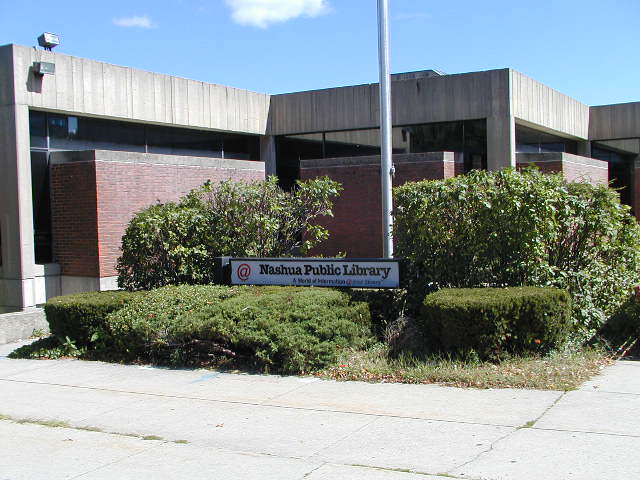
How the Domestic Church Preserved the Faith in Soviet Russia
And how it can do the same here...and be the foundation for evanglesation
This is an interview with His Excellency Athanasius Schneider ORC, auxiliary bishop of Astana, Kazakhstan and titular of Celerina. Bishop Schneider is a noted author and speaker. His best known work is Dominus Est – It is the Lord! – a defense of the traditional discipline of receiving communion.
This is a translation of an interview, first published in Polish after his recent visit to Poznan, Poland, and it first appeared in Polonia Christiana magazine. The interview was by Izabella Parowicz, whom I met at the Sacra Liturgia conference on the sacred liturgy in Rome last summer .
What I find particularly interesting is his description of growing up in the former Soviet Union when, at some periods, there was no possibility of attending Mass at all. He describes how the profound reverence for Our Lord he saw in his family members and for the Blessed Sacrament during adoration was transmitted to him and others around him. Ironically, irreverence in the Mass came to the former Soviet Union from missionary priests from the West once there was relaxation of political control. He talks, for example, of how even when the Novus Ordo was introduced in Kazakhstan, it was celebrated as a matter of course in Latin and ad orientem and with such reverence that it was not noticeably different to the celebration of the Extraordinary Form (as it is referred to now).
This highlights the power of the home, of the Domestic Church, in preserving and nurturing the Faith in a powerful way; and in inculturation. This story tells of how even the sense of the liturgy was preserved through right prayer at home. We could learn from this today and see it as part of our mission of evangelisation. If we focus on ourselves first and get that right, then the light will shine and draw people towards it despite ourselves!
I should mention that Izabella did the translation and asked me to correct any grammatical errors (Polish is her first language). I was reluctant to make too many changes for fear of inadvertently changing precise meanings, but did do so on some occasions nevertheless. So please be aware, that if there appears to be any confusing terminology or error, it is almost certainly due to my misunderstanding and ignorance!
Here is the interview (the photographs were taken at a Pontifical Mass celebrated by Bishop Schneider in Poznan):
Izabella Parowicz: Your Excellency is ethnically German but you were born and raised in the then Soviet Union. How has this come about? Bishop Athanasius Schneider: In the beginning of the 19th century (1809-1810) there was a great emigration of farmers from southwest Germany to the Black Sea region in the former Russian Empire. They emigrated from the regions such as Baden, Elsass, Lothringen, Pfalz. The Tsar granted to them gratis plots of very fertile land (“chernozem”, black earth). They were permitted to establish exclusively German speaking villages, and were separated also by their religious confession (pure Catholic and Lutheran villages) with German names, such as Strassburg, Elsass, Karlsruhe, Baden, Mannheim, Speyer etc. My ancestors emigrated from Alsace, near the town Seltz and Hagenau. They lived there until the Second World War. After the war the Stalinist regime deported them to several places in the Soviet Union for internment under hard labour. So my parents were deported to the Ural Mountains. After they were freed, they moved to central Asia, Kirghizstan, where I was born.
Your Excellency’s childhood must have been affected by the omnipresent persecutions of the Faith imposed by the Soviet regime. Under what conditions was it possible for Your Excellency and His family to practice their Faith? How did Your Excellency’s religious life develop and who played the most important role in it?
The communist regime had the aim to establish a society without God. So every public religious sign of worship was forbidden. The faith was lived and handed on in the families, thanks to the Catholic family as domestic church. I had the great privilege and happiness to be born in a very Catholic family, and I received the Catholic faith, so to speak, with my mother’s milk. During the persecution and in the absence of a priest (which sometimes took some years), my parents celebrated and sanctified each Sunday with the children by common prayers in the morning. Later we moved to Estonia, where we had a church and a priest some 100 km away. So we traveled the 100 km to participate in the Holy Mass each Sunday. We liked these Sunday journeys to the Church, even though this demanded some sacrifice. Our family had the privilege of knowing personally two saintly priests: Blessed Father Alexij Zaritzki, a Ukrainian priest from Lviv, who died as a martyr in the Gulag in Karaganda in 1963 and who was beatified in 2001; and Father Janis Andreas Pavlovsky, a Latvian Capuchin, who suffered as confessor of the faith in the Gulag in Karaganda. He was my parish priest in Estonia and died in Riga in 2000.
As a teenager, in the 1970s, Your Excellency was allowed to return to Germany together with your family. Finally it became possible to practice the Faith freely. What were Your Excellency’s first experiences in this regard?
We are talking about the times in which many of the unfortunate, post- conciliar liturgical reforms had already been implemented. We, who lived the Catholic faith during the persecution, were thinking about Germany and the Western world like a “paradise”. In the persecuted church we lived a profound faith with a great reverence towards all sacred realities, the priest, the liturgy and especially Holy Communion. What shocked us so deeply now was the lack of reverence and sacredness in the liturgy of the Holy Mass. We observed for the first time in our life the unbelievable scene of the distribution of the Holy Communion on hand. It seemed to us so banal and so common - like the distribution of cakes. As we returned at home, we felt a silent pain in our souls. When my mother found that this was the situation in almost all other churches we visited, she suffered so deeply that she cried.
Your Excellency frequently emphasises that Holy Communion should be received in the mouth and in the kneeling position. What are the gravest risks and consequences of the widespread practice of receiving Holy Communion in the hand (both in objective terms as well as for the faith of an individual)? The gravest risk and consequence of the practice of Communion on hand is the enormous loss of the Eucharistic fragments and the consequently the fact that these fragments are trampled under the feet of the people in our churches. The next serious risk is the great risk it creates for the stealing the sacred host. Clearly also this practice weakens the Faith because when the Holiest of Holies is treated like common food and without appropriate gestures of adoration, it undermines the conviction of the truth of the Real Presence and in the doctrine of Transubstantiation.
Some Catholics who support (or simply are used to) receiving Holy Communion in the hand make the following arguments: they argue that a person’s hand tends to sin less than his mouth; they say that holding Our Lord in their hands gives them a beautiful opportunity to adore Him for a while; they also argue that kneeling would be against their human dignity and that the standing position is more appropriate and equally respectful. How would Your Excellency respond to these arguments?
The organs of our body (hand, tongue etc.) are not guilty of the sin. The guilt is imputed to the human person. The organs used by the human person to commit a sin, remain always innocent. That lay people may hold the sacred Host in one’s hand in order to adore the Lord contradicts the entire tradition of the universal Church. This practice is a subjectivist, though pious, exaggeration. The right to touch the sacramental Body of Christ the Church was always reserved to the ordained ministers. Exceptions were made during the time of persecution or in the case of a very grave necessity for objective reasons, but not in order to satisfy individual piety. Even during the first centuries, the Blessed Sacrament was not touched by the lay people with their fingers, but they took the sacred host directly with their mouth from the palm of their hand, and the women would cover their hands with a white cloth. The standing position does have value at certain times. It is a typical Christian position, because the Christian is a person who is redeemed and lives a new life and believes in the resurrection of the body. But the kneeling position is a typical Christian position as well, and is used in the moments and acts of adoration of God, of Christ, the Incarnate God. It is used also to express the prayers of petition, penance and contrition. Our Lord Himself prayed kneeling, so also the Apostles, the women in the Easter morning of the Resurrection. The kneeling gesture is shown in the Heavenly Jerusalem, where the Angels and the redeemed mankind prostrate themselves on their knees and even on their face to adore Christ, the Lamb of God. Therefore the most biblical, the most appropriate and logical gesture is the kneeling position in the moment when the faithful greets and receives the Lamb of God under the veil of bread.
We say we believe in God yet we do not know how to revere Him appropriately; we do it in our own, frequently lamentable ways. What may be the reasons for the diminishing of reverence shown to Jesus Christ Our Lord? What pastoral and catechetical solutions would Your Excellency recommend to restore this reverence?
The nature of human being consists of an invisible and of a visible part, that is of the union of the spiritual soul and the material body. Consequently, man has to act according to his nature, and that means in our case: he has to adore God simultaneously with an interior and with an exterior act. The interior act is the most important and animates the exterior act, but the exterior act must not to be neglected. To stress only the interior and neglect the exterior act, brings us to the inhuman attitudes of Platonism and Gnosticism. To stress only the exterior act, forgetting and neglecting the interior act, brings us to hypocrisy and lifeless formalism. Our Lord said: “These ought you to have done, and not to leave the other undone” (Mt 23:23). In view of restoring the reverence it is indispensable to teach and preach faithfully and completely the truth of the Eucharistic Sacrament, especially the Real Presence and Transubstantiation; this has to be accompanied with the introduction of exterior reverent gestures.
Although the possibility of receiving Holy Communion in the hand was introduced in Poland in 2005, it is still, thanks be to God, not really widespread. There are, however, other sad novelties being introduced: the seat of the celebrant is being placed centrally between the altar and the Tabernacle (so that, while seated, he is showing his back to Our Lord), altar boys, when passing from one side of the presbytery to the other, bow reverently (but rather unreflectively) towards the empty altar table while having the Sanctissimum, the King of Kings, right behind them. We also observe a phenomenon of a “fraternization” of the faithful, especially youth, with Our Blessed Lord Jesus Christ. This “fraternization” is accompanied by a trivialisation and infantilization of the way we worship God and it is often approved, if not promoted, by priests. When approached on these matters, parish priests usually plead newest liturgical or pastoral instructions as an excuse and generally, they do not wish to discuss such issues with the “troublesome” faithful. What arguments should we use to convince our shepherds that lex orandi does affect our lex credendi? Are we as laypeople at all entitled to admonish our priests (in the way that Our Lord Jesus commanded in the Gospel) whenever reverence towards Our Lord is at stake?
The supernatural knowledge of the truth of the faith about the greatness of the Eucharistic mystery has to grow firstly in the clergy. Also the laws of the authentic Christian and Catholic worship have to be better known according to the immutable Tradition and the perennial teaching of the Magisterium (“perennis sensus ecclesiae”). The fundamental law of the Divine worship is this: God, Christ, the eternity is the center and all aspects and details of the worship have continuously be subordinated and be directed to Him (so spoke the II Vatican Council in “Sacrosanctum Concilium”, 2). When the celebrating priest puts his chair in the center, he visibly stresses that in the liturgy man is in the center. This contradicts the teaching of the Church, especially the teaching of Vatican II already referred to. When instead the tabernacle and the Cross with the image of Christ remains in the center, with the chair of the priest on the side, this expresses the truth the Christ is the president, the leader and the head of each Eucharistic liturgy. Christ is the Head of His Mystical Body, and therefore Christ is also the Head of His “liturgical body”. Since Christ is incarnated and liturgy is sacramental, the truth that Christ is the center and the Head has to be also visible, that is: His Real Presence in the Tabernacle and His visible image on the Cross have to be in the center of the church and of the Eucharistic liturgy. The Second Vatican Council and Canon Law encourages the lay people to express to the clergy their concerns about the spiritual good of the church (cf. II Vatican Council “Lumen gentium”, 37; can. 212 and can. 213 CIC). Therefore each lay person has the right to ask the clergy to correct scandals and abuses which contradict the spiritual good of the souls and the rights of God Himself. The Church gives to the faithful such a right: “Any Catholic, whether Priest or Deacon or lay member of Christ’s faithful, has the right to lodge a complaint regarding a liturgical abuse to the diocesan Bishop or the competent Ordinary equivalent to him in law, or to the Apostolic See on account of the primacy of the Roman Pontiff” (“Redemptionis Sacramentum, n. 184”).
Blessed John Paul II said in the year 1980 that “to touch the sacred species and to distribute them with their own hand is a privilege of the ordained”. What is Your Excellency’s opinion of the lay ministers distributing Holy Communion?
Although (at least in Poland) they are usually carefully selected, respected men, husbands and fathers, their ambiguous, growing role is somewhat disturbing. The fact that lay people distribute the Holy Communion during the Eucharistic Sacrifice contradicts the entire tradition of the universal Church (East and West) and was never practiced. It is an absolute “novum” and a real rupture with the Tradition. Holy Communion could be distributed to the faithful, in times of persecution and by the eremites in the desert, but always outside the Holy Mass. The introduction of lay ministers is justified by the argument that it saves time and lightens the burden of the priests in distributing Holy Communion to a very big crowd. When one considers and accepts the incomparable greatness and sacredness of the Holy Communion and that this moment of receiving the Eucharistic Lord is really the summit in the life of a Catholic, nobody - neither priest, nor other faithful - could justifiably look at their watches counting the minutes or lament tiring circumstances. The reality nowadays shows us the following: in churches where lay ministers are engaged in distributing Holy Communion, the priest after Holy Mass wastes time in chatting with people or engaged with internet and television. So in these cases the priest often wastes more time after Holy Mass than he would use when distributing Holy Communion alone and without lay ministers. The other justification in engaging lay ministers is this: to express the active participation of the lay people in the liturgy. This is a wrong understanding of active participation and contradicts the teaching of the Magisterium and the Tradition of the Church. To distribute Holy Communion is an essential part of the ordained ministry and was never in the Church a means of active participation of the laity. The Second Vatican Council teaches: “In liturgical celebrations each person, minister or layman, who has an office to perform, should do all of, but only, those parts which pertain to his office by the nature of the rite and the principles of liturgy” (Sacrosanctum Concilium, 28) and “To promote active participation, the people should be encouraged to take part by means of acclamations, responses, psalmody, antiphons, and songs, as well as by actions, gestures, and bodily attitudes. And at the proper times all should observe a reverent silence” (ibid., 30). There is no mention for lay ministers of Holy Communion as means of active participation, because such an understanding and such a measure contradict the perennial tradition of the Church and the following principle, taught by Vatican II: “There must be no innovations unless the good of the Church genuinely and certainly requires them; and care must be taken that any new forms adopted should in some way grow organically from forms already existing” (ibid., 23).
In Your beautiful book on Holy Communion entitled “Dominus Est”, Your Excellency described the role of the “Eucharistic women” in the Soviet Underground who, in the absence of priests, managed to preserve the flame of Faith by adoring Our Blessed Lord in the Eucharist so as to be able to receive Him at least spiritually. Your Excellency described a moving story of your mother, Maria Schneider, who was, exceptionally, allowed by a priest in hiding to administer Holy Communion to her sick mother, on condition that she would do it with greatest possible respect. Your Excellency’s mother put on new white gloves and with tweezers gave Holy Communion to her mother. Eventually she burned the envelope in which the consecrated Host had been kept. This is a description of women acting with profound respect and in extraordinary circumstances; in contrast, nowadays there is certain confusion with regard to the increasing involvement of women in all areas of the liturgical service (whether as altar girls, ministers of Holy Communion or even “pastoral assistants”). What should be the limits of such female activity and what arguments should be used to discourage women from getting involved in the altar service?
The role of the woman in the Church is determined by God Himself and corresponds to the laws which God in His wisdom and love has written in regard to the role of women. The order of the creation of the human nature in two sexes reflects beauty and complementarity rather than rivalry. In the supernatural order of the life of the Church the supreme and most beautiful model for a Christian woman is Mary, the Mother of God. The most profound and most beautiful characteristic of a woman is her maternity. Christ, the Incarnate God and Eternal High Priest assumed the human nature in the male sex and in His wisdom He linked irrevocably the ministerial priesthood in all degrees and services with the male sex, for it represents the spiritual paternity of Christ Himself. The degrees of Christ’s priesthood are the episcopacy and the presbyterate and these represent the highest level of the serving on the altar. The diaconate in its services of the altar and of the word represents this episcopal and presbyterial service in a concrete and sacramental form. All the other orders and services beneath the diaconate (sub- deacon, acolyte, lector, altar boy) are exercises of the diaconate in a non-sacramental form like an unfolding of the diaconate and ultimately also of the presbyterate and the episcopacy. Accordingly, the universal and perennial tradition of the Church is never to admit women to the service of the altar or of the word during the Eucharistic Sacrifice, which is the liturgy of the ministerial priesthood. During the liturgy of the hours, which is not a priestly and sacrificial liturgy in the strict ministerial sense, lay people and women, however, could accomplish the service of lectors. The ultimate model of the sacrificial liturgy in the strict ministerial sense is the liturgy of the Last Supper, where there were only the twelve Apostles and even not Mary, the Mother of God. The Cenacle of the Last Supper corresponds to the altar space or to the “presbyterium” nowadays in our churches. Therefore during the Eucharistic Liturgy women were never acting within the altar space, but within the nave of the church, because the nave symbolizes the common priesthood and together with the altar space, the “presbyterium”, shapes the entire church, or the entire priesthood of Christ, consisting in the ministerial and the common priesthood as one body, but with essential different functions (cf. II Vatican Council, “Lumen gentium, 10”).
I would like to touch upon the hygienic aspect of receiving Holy Communion in the mouth. I find it simply impossible that any disease might be spread through Our Lord Who is substantially present in the consecrated Host and, to my knowledge, the Church has never in history been accused of causing or spreading any epidemics. Nevertheless, there was recently a case that the receiving of Holy Communion in the mouth was temporarily banned and distribution of Holy Communion in the hand was instead introduced by a national Conference of Bishops due to the fear of swine flu. As one could expect, this has resulted in a drastic diminishing of the respect for the Blessed Sacrament and even after the ban was lifted, almost no one in that country has been receiving Holy Communion in the mouth ever since in view of the “hygienic concerns” which sadly seem to outweigh the belief in the Real Presence. I would like to ask Your Excellency if such instances of epidemics should be at all considered valid reasons for introducing distribution of Holy Communion in the hand? Would an episcopal recommendation for making a Spiritual Communion be a viable alternative for such situations of epidemics? Indeed in the two thousand years of Christian liturgy it was not heard, that through the Holy Communion there were transmitted deceases and epidemics. It is demonstrated that the palm of the hand contains more bacteria than the tongue. Everybody uses the saliva to make the first disinfection on a wound, but will never use the fingers of the hand for this purpose. The hand of a person who receives Holy Communion in the hand has usually previously touched many objects which are full of bacteria and dirt: the door-handles in the public places and in the church, but especially coins and paper money. With such unwashed fingers these persons touch the sacred host, leaving upon it the imprints of a huge quantity of bacteria which is then placed in their own mouth. Indeed it is Communion in the hand that is unhygienic. When a diocesan authority has sincerely “hygienic concerns” he has firstly to forbid the Communion on hand. In some rare cases of a dangerous epidemic a recommendation for making spiritual Communion would be a viable alternative. We have indeed to rediscover and esteem the fruitful practice of spiritual Communion.
My next question concerns the possible ways of avoiding the risk of sacrilege during Holy Masses which are celebrated for large crowds and which may be (partly) frequented by people who are not baptised Catholics (or not even Christians), who came for a Holy Mass out of curiosity and who, however, do not refrain from receiving Holy Communion. While the practice of distributing Holy Communion in the mouth as requested by our beloved Pope Emeritus Benedict XVI and maintained by our Holy Father Francis seems to be a natural “filter” which can prevent non- Catholics from receiving it, what other means could be implemented by priests in situations in which the risk of committing a sacrilege is too high? The Church from the beginning of her historical journey always protected the Holiest of Holies, the “sanctissimum”, the Body of Christ in the Eucharistic sacrament, according to the admonition of the Lord: “Give not that which is holy unto the dogs, neither cast ye your pearls before swine” (Mt 7:6). In the Eucharistic liturgy during the first centuries after the liturgy of the word all catechumens and all unbaptized were dismissed. The deacon proclaimed: “Catechumen go away. That no catechumen may remain”. These words the Byzantine Liturgy uses still nowadays. The Church had a special liturgical service that of the “porter” (ostiarius), who vigilantly had to watch that no unbaptized would receive Holy Communion and no person with bad intentions would disturb or profane the liturgy and the sacred place. It is a real pastoral demand to restore universally in the Church the order and the service of such a porter. In the Byzantine Liturgy the person who receives Holy Communion has to say his name, has to identify himself to the priest who distributed Holy Communion. This manner makes the rite of Holy Communion more personal, giving an atmosphere of a family and in the same time provides more security against profanations. This could be also adopted by the Church of the Latin Rite.
When going to the church in the Western European countries, Catholics who wish to receive Holy Communion in the kneeling position and in the mouth are sometimes treated by priests with aversion. Once (with the tears in my eyes) I had to beg a priest to give me Holy Communion in the mouth as he kept refusing to do so. Eventually, he gave it to me with an evident disgust. What, according to Your Excellency, is better: to persist and to be ready for a reprimand or even a verbal conflict with the priest in the moment in which one should be solely focusing on reception of Our Blessed Lord? Or should one rather decide to make in such instances the Spiritual Communion so as to avoid any heart- or conscience-breaking situations? Is there perhaps another alternative? The Church law is very clear: no priest or bishop has the right to refuse to the faithful Holy Communion only because the of wish to receive it kneeling and on the tongue. This right of the faithful is laid down in the Instruction “Redemptionis Sacramentum”, n. 91. The violation of this norm the Church considers as “grave matter”: see the mentioned Instruction, n. 173. The Church admonishes the sacred ministers with these grave words: “Let each one of the sacred ministers ask himself, even with severity, whether he has respected the rights of the lay members of Christ’s faithful, who confidently entrust themselves and their children to him, relying on him to fulfill for the faithful those sacred functions that the Church intends to carry out in celebrating the sacred Liturgy at Christ’s command. For each one should always remember that he is a servant of the Sacred Liturgy” (“Redemptionis Sacramentum”, n. 186). To refuse a faithful Holy Communion only because of a wish to receive it kneeling or on the tongue, constitutes an unbearable clericalism and clerical despotism.
For about 15 years Your Excellency has been performing His priestly and episcopal ministry in Kazakhstan. For many dozens of years the faithful in the former Soviet Union had not been allowed to hear Holy Mass, they had been deprived of priests and sacraments. The missionary priests who went there in 1990s must have naturally introduced Novus Ordo Missae and a number of new, formerly unknown liturgical or pastoral practices which were as such less reverent towards the Sanctissimum. What was the reception of these novelties by those Catholics who still remembered the old Mass and whose religious formation was much more traditional?
The Novus Ordo had already been introduced into the former Soviet Union in the early 1970s. But it was celebrated with the spirit of the Vetus Ordo, with deep faith and reverence. In my own parish, to which I belonged from 1969-1973 in Tartu/Estonia, the Holy Mass was celebrated according to the Novus Ordo, but “versus Deum” at the High Altar, in Latin, Communion on the Communion Rails kneeling and on the tongue. So for my parents and me there was almost no perceptible difference between the two “ordo”. The celebration “versus populum” was introduced in Kazakhstan still in the time of Soviet Union, but the manner of celebration was very reverent. It was introduced out of devout obedience towards the indications of the Holy See. After the downfall and disintegration of Soviet Union there came many missionary priests from different countries. Some of these priests introduced liturgical practices which are not according to the life of devotion of the faithful inherited from the time of persecution. Such practices were for example receiving Holy Communion standing, the use of guitars and clapping hands during Holy Mass, sentimental songs and songs with worldly melodies during the liturgy. But thanks be to God the Conference of the Catholic Bishops of Kazakhstan established the norm, that the only admitted manner to receive Holy Communion is kneeling and on the tongue, except in the case of persons who physically are impeded to kneel.
How would Your Excellency describe the faith of His flock? Are they still more reverent towards the Sanctissimum than the Western Catholics or was their piety too much affected by the state atheism? The Catholics in Kazakhstan conserved the precious heritage from the times of persecution, it means: a deep faith; great reverence towards the liturgy and especially towards the Holy Eucharist; a clear conscience of sin, therefore the faithful receive frequently the sacrament of penance; a great love for prayer and especially for Eucharistic adoration; love and reverence towards the priests and the bishops; a general clear sense and reverence of the sacred.
In the Eastern Churches no drastic liturgical reforms were introduced in the 20th century. Has, according to Your Excellency’s observations, the reverence for the Eucharistic Christ been preserved in these churches or was it rooted out by the influence of the Soviet atheism? The Eastern churches, either Catholic or Orthodox, conserved still a great reverence towards the liturgical tradition. To change the liturgy means for them to change the faith. They are profoundly rooted in the fidelity to the faith and to the liturgical tradition. The liturgy is something that they consider a sacred treasure, which the Church has carefully to conserve and to hand over to the following generations. Such an attitude of the Eastern, and of the Orthodox churches is a value which can and should enrich the Latin Church in these days of a great doctrinal and liturgical crisis. This is my experience from my contacts with the clergy and the faithful of the Orthodox church. To learn and to accept the liturgical spirit and fidelity of the Orthodox churches would be one of the best ecumenical gestures on the part of the Catholics.
We can never show enough reverence for our Blessed Lord. How can we train ourselves in continuously improving it? Could Your Excellency offer us some practical advice in this regard? First we have to know better the fullness of the Catholic faith about the Eucharist, especially the very rich documents of the Magisterium. Then it will be also helpful to read the lives and examples of the Eucharistic Saints and Martyrs. Then we have to express our faith with clear gestures of reverence, adoration and devotion towards the Eucharistic Lord. The practice of Eucharistic adoration is spiritually fruitful. We have to promote the Eucharistic adoration there, where we live and even establish groups or fraternities of Eucharistic adorers. We have also to console Our Lord because of the enormous and numerous acts of sacrilege and irreverence and offer in the spirit of penance through the hands of the Blessed Virgin Mary, the Eucharistic Woman, acts of expiation and reparation according to the example of the Angel, who appeared to the children of Fatima.
In conclusion, I would like to ask what is Your Excellency’s definition of a saintly priest? A saintly priest is that priest who is conscience of what he is, objectively and ontologically: “alter Christus”, and who tries with the grace of God to become each day more “alter Christus” also in his mind, his intentions, his words and deeds according to the spirit and the example of Christ, the Eternal High Priest, the good Shepherd, who lays down his life for the eternal salvation of the immortal human souls, who does not seek his own profit, but entirely the glory of God and the spiritual good of the souls. And the greatest help in this process is then, when he every day celebrates with deeper faith and deeper love the sacrifice of the Holy Mass.
+ Athanasius Schneider, Titular Bishop of Celerina and Auxiliary Bishop of the archdiocese of Saint Mary in Astana, Kazakhstan 01.08.2013
Learn Traditional English Style of the 13th Century - Sacred Art Painting Class to Take Place at TMC in March
 I will be offering a four-day sacred art class at Thomas More College from Monday to Thursday during the Spring Break, March 10-13. This is offered free to students from Thomas More College and is also open to adults from outside the college. The hope is that the others will help subsidize the places for the students (who nevertheless will have to pay for room and board in the dorms during this week). The cost to those from outside the college is $525 for the four days, and includes all materials (for egg tempera painting), tuition, lunch, and a lecture in the evening. For and additional $15 per day dinner can be included. Because this is during the academic year, we cannot offer those from outside rooms in the dormitaries so they will have to arrange. There is a local hotel that offers favourable rates to those connected to TMC and has a free shuttle to and from the campus.
We will be studying the English gothic style that is often described as the school of St Albans. Its leading artist in the 13th century was a monk called Matthew Paris. Typical images would be those that you see in Westminster Psalter (if you google image this you will see some). We see some of his work here, above, /St Christopher, and then students' work below.
I will be offering a four-day sacred art class at Thomas More College from Monday to Thursday during the Spring Break, March 10-13. This is offered free to students from Thomas More College and is also open to adults from outside the college. The hope is that the others will help subsidize the places for the students (who nevertheless will have to pay for room and board in the dorms during this week). The cost to those from outside the college is $525 for the four days, and includes all materials (for egg tempera painting), tuition, lunch, and a lecture in the evening. For and additional $15 per day dinner can be included. Because this is during the academic year, we cannot offer those from outside rooms in the dormitaries so they will have to arrange. There is a local hotel that offers favourable rates to those connected to TMC and has a free shuttle to and from the campus.
We will be studying the English gothic style that is often described as the school of St Albans. Its leading artist in the 13th century was a monk called Matthew Paris. Typical images would be those that you see in Westminster Psalter (if you google image this you will see some). We see some of his work here, above, /St Christopher, and then students' work below.
Contact me through this site if you are interested.
And below we have a the original Visitation and then my version of it.
At Work in My Parents' Garden in Cheshire, England
 As an antidote to the gloom of ever shortening days I am posting some photos taken in England in the summer. I was back there in August and took these photos of my parents' garden. Some will remember that I showed photos of this garden just a year ago, in an article here called A Gardon is a Lovesome Thing, God Wot. when just in its second season. Fifteen months later and it is maturing so that the herbacious borders look packed out! I was immediately put to work doing some dead-heading and weeding. I can't claim much credit for the beauty of it, though. What is remarkable given that my Dad and Mum haven't been able to do much work on it this year, is how beautiful it is when for long periods it has just left to grow on its own. The look of it is down to careful planning in the design and planting.
My parents winter in Spain and the Spanish influence is obvious with the removal of the lawn and courtyard type layout with large terracotta plants (also another labour saver as there is no lawn mowing to be done).
As an antidote to the gloom of ever shortening days I am posting some photos taken in England in the summer. I was back there in August and took these photos of my parents' garden. Some will remember that I showed photos of this garden just a year ago, in an article here called A Gardon is a Lovesome Thing, God Wot. when just in its second season. Fifteen months later and it is maturing so that the herbacious borders look packed out! I was immediately put to work doing some dead-heading and weeding. I can't claim much credit for the beauty of it, though. What is remarkable given that my Dad and Mum haven't been able to do much work on it this year, is how beautiful it is when for long periods it has just left to grow on its own. The look of it is down to careful planning in the design and planting.
My parents winter in Spain and the Spanish influence is obvious with the removal of the lawn and courtyard type layout with large terracotta plants (also another labour saver as there is no lawn mowing to be done).
Has Pope Francis Saved Western Culture?
 One small change to the wording of the mission of the Anglican Ordinariate, instituted by Pope Francis might have a profound effect on how it participates in the Church's mission of evangelisation; and on English speaking culture.
When I was at the Sacra Liturgia Conference this past summer, speaker after speaker emphasised the importance of Latin as the norm in the Roman rite. Nevertheless, a warm welcome was given also to several priests from the Anglican Ordinariate, which will rarely offer Mass in Latin, and it was offered the platform when Mgr Keith Newton gave a talk in which he described progress in establishing the precise form of the Ordinariate liturgy. I heard no one say that they saw any contradiction in this. Similarly, the developments in the Ordinariate Use liturgy are, apparently enthusiastically, reported on this site as they occur and have been ever since it was created. The fact that the Ordinariate Use is taken seriously by all these traditionally minded Latin-orientated Catholics seems to me to indicate a recognition of the general point, that the vernacular does have an important place in the liturgy; and more particularly that English has a privileged position amongst vernaculars. Where might this be going in the future, I wondered?
One small change to the wording of the mission of the Anglican Ordinariate, instituted by Pope Francis might have a profound effect on how it participates in the Church's mission of evangelisation; and on English speaking culture.
When I was at the Sacra Liturgia Conference this past summer, speaker after speaker emphasised the importance of Latin as the norm in the Roman rite. Nevertheless, a warm welcome was given also to several priests from the Anglican Ordinariate, which will rarely offer Mass in Latin, and it was offered the platform when Mgr Keith Newton gave a talk in which he described progress in establishing the precise form of the Ordinariate liturgy. I heard no one say that they saw any contradiction in this. Similarly, the developments in the Ordinariate Use liturgy are, apparently enthusiastically, reported on this site as they occur and have been ever since it was created. The fact that the Ordinariate Use is taken seriously by all these traditionally minded Latin-orientated Catholics seems to me to indicate a recognition of the general point, that the vernacular does have an important place in the liturgy; and more particularly that English has a privileged position amongst vernaculars. Where might this be going in the future, I wondered?
Then shortly after returning from Rome I read in Damian Thompson's blog in the Telegraph an article that was headed Pope Francis Embraces the Ordinariate and Increases Its Power to Evangelise. In it he said: 'Francis has widened the remit of the Ordinariates in Britain, America and Australia. Until now, only ex-Anglicans and their family members could join the new body. But, thanks to a new paragraph inserted into the Ordinariate's constitution by Francis, nominal Catholics who were baptised but not confirmed can join the structure. Indeed, the Holy Father wants the Ordinariates to go out and evangelise such people.'
The paragraph he referred to was Complementary Norms, Article 5 §2: 'A person who has been baptised in the Catholic Church but who has not completed the Sacraments of Initiation, and subsequently returns to the faith and practice of the Church as a result of the evangelising mission of the Ordinariate, may be admitted to membership in the Ordinariate and receive the Sacrament of Confirmation or the Sacrament of the Eucharist or both. This confirms the place of the Personal Ordinariates within the mission of the wider Catholic Church, not simply as a jurisdiction for those from the Anglican tradition, but as a contributor to the urgent work of the New Evangelisation. As noted by the Congregation for the Doctrine of the Faith, enrolment into a Personal Ordinariate remains linked to an objective criterion of incomplete initiation (i.e. baptism, eucharist, or confirmation are lacking), meaning that Catholics may not become members of a Personal Ordinariate for purely subjective motives or personal preference.’
I have no special inside knowledge on the Ordinariate or the intentions for it. But I am struck by the potential for a profound affect on the wider culture globally for the good of what has happened recently. This is because of the relationship between liturgy and culture. Again, at Sacra Liturgia 2013, many speakers echoing Pope Benedict in the Spirit of the Liturgy, emphasised the connection between liturgy and culture. We were told for example, that an education in art, architecture, music and literature was necessary for the development of one's 'liturgical instincts'. The forms of the culture that we should study, therefore, are those that point us to liturgical forms (Catholic educators take note!); and those liturgical forms ought to be a 'liturgical high culture' - elevated cultural forms that draw us upwards but are nevertheless accessible and easily grasped.
The connection between the liturgy and culture is profound. Man is made to worship God; his worship is what establishes and shapes that relationship with God; and this, in turn influences all our human interactions and is the most significant factor in contributing to the grace and beauty of our actions and interactions. The culture might be viewed as the aggregate, the vector sum of these and is a reflection of - or incarnation of - our core values, priorities and beliefs.
While this connection can be conceived as a symbiotic dynamic, with each - liturgy and culture -simultaneously reflecting and nourishing the other, the relationship between the two is not a partnership of equals. The liturgy is a more powerful influence on the culture than the culture is on the liturgy. So in consideration of a reform of the culture, we should always look to ourselves first and strive for liturgical orthodoxy and purity. Accordingly we should strive to have liturgical culture high culture that is noble and naturally accessible. This is a culture that it makes high demands of those who create these forms - the writers, artists, composers and architects - but never of those who see it and hear it. It should touch people and then draw them upwards through the beauty of its forms, in harmony with worship. This accessible divine beauty can touch the soul in a way 'beyond words' (I'm thinking of St Augustine here).
In his book on the liturgy published first in 1918, the Spirit of the Liturgy, Romano Guardini tells us that liturgical forms are necessarily reflective of a high culture: 'Culture enables religion to express itself and helps distinguish the essential from the non-essential...as a rule, the spiritual life should be impregnated with a genuine and lofty culture... If the cultural element of prayer declines, the ideas become impoverished, the language coarse, the imagery clumsy and monotonous and the emotional paltry and artificial.' (p34)
He also describes the influence in the other direction, that the appropriate forms in the liturgy inspire and sustain a vibrant and beautiful contemporary culture: "The liturgy possesses a tremendously compelling form of expression, which is a school of religious training and development to the Catholic who rightly understands it and which is bound to appear to the impartial observer as a cultural formation of the most lofty and elevated kind." (p47; pub Herder and Herder).
Historically, if we look at the art, music and architecture we can see how the liturgical forms have influenced the culture. The baroque of the 17th century, for example, started off as part of the renewal of the Catholic counter-reformation and then the liturgical forms became the models in style for the profane (as in not explicitly sacred) forms as well.. So powerfully striking and beautiful was the wider culture created by this, that it became the standard throughout Europe, even in the protestant lands, for example, the Netherlands and England. The public buildings, the portraits and landscapes of their artists and even the music took inspiration from the Catholic liturgical culture.
The effect can be negative as well. If the liturgy is not beautiful and the cultural forms that are associated with it are deliberately made to take their inspiration from the wider secular culture that is not derived from liturgical forms, then a downward spiral is created in which the culture of faith and contemporary culture in turn cause the decline of the other. This is what we have seen most strikingly in modern times, accelerating in the 20th century (although the signs were there before that).
Catholics cannot ignore this question of contemporary culture. Even if we imagine a situation in which you have healthy and beautiful liturgical culture and that is also somehow disconnected from the wider culture and stable (a situation I can't imagine would ever be the case) we would still have a duty to try to transform the contemporary culture into one that reflected this liturgical culture. This is because those who do not go to church will not see the liturgy, which is our most powerful tool in evangelisation. But they do see the wider contemporary culture every day of their lives. If the wider culture reflects the beauty of the cosmos nourished by the liturgy, then its power will draw people to God and to His Church and provoke a curiosity and receptivity to the Word. This is the message of recent Popes in emphasising the power of beauty (for example Pope Benedict in his discussion of the via pulchritundinis). This is why incidentally, on a blog about liturgy, I consider it relevant to consider how this connects with secular culture - in my opinion we must not separate the two.
And what of the Ordinariate Use liturgy? Latin liturgy can stimulate a beautiful Catholic culture in any language of course but, I believe, the opening up of the traditional Anglican forms adapted for use in the Ordinariate supports this in a new and powerful way. The Anglican Ordinariate has elevated liturgical forms that do not look to modern secular culture for inspiration (unlike many of those in other vernacular liturgies), but rather, to the authentic Roman Church tradition and English high culture of the past. Therefore it can act powerfully to evangelise the culture of English speakers.
Why the special focus on English? I suggest that the influence of English in the world is great and is steadily increasing and hand in hand with this is English speaking culture, for good or ill. One might say that English is the lingua vulgata - the common language - of our age, and who knows for how long afterwards, perhaps centuries. It is the second most spoken (after Mandarin) as a first language and if you take second languages into account the gap is narrowed and getting narrower, for English is the international language of business and technology. This was emphasised to me recently when listening to Venezuelan radio and a discussion in Spanish (translated by my wife) about the fact that English is beginning to influence the way that Spanish is spoken by the general population as it incorporates its vocabulary and idioms.
It therefore becomes vital that we evangelise Western culture which is spreading globally, and a liturgy rooted in English language is a powerful means of doing this. Now that the Ordinariate Use is free to reach out beyond former Anglicans this can be at the centre of this. It might not be only through direct effect - one could envisage the situation where it's forms might also have an impact on the Roman Rite in English which is the not Ordinariate Use. At Thomas More College of Liberal Arts, where I teach, we regularly have the Extraordinary Form, and the Ordinary Form in English and Latin. We also sing the Liturgy of the Hours daily, with the psalms most commonly sung in English. For our vernacular liturgies we look to these Anglican forms of music and prayer in our vernacular liturgy for inspiration, even though it is not Ordinariate Use.
Incidentally I have heard some argue openly that they do not like to see a well done vernacular, or even Latin Novus Ordo, because they feel that the worse the alternatives are, the more likely it is that the Extraordinary Form will dominate. I do not accept this approach at all. In my mind, we should strive to make our participation in all liturgy (vernacular or not, Ordinariate Use of not) dignified and beautiful; in my mind this supports rather than diminishes the re-establishment of Latin in the liturgy in such a way that participation is active (in the proper sense of the word).
If we are to evangelise the English speaking world, which increasingly means the whole world, in a powerful way it could be a through a contemporary culture of the English. This contemporary culture could develop powerfully out of a beautiful English language liturgy that points to that of Shakespeare and Donne; and musical forms that are derived from the pre-reformation Sarum Liturgy. I would hope to see a flourishing of creativity inspired by this in which noble and accessible forms of both liturgical and contemporary culture are produced (in the way the Shakespeare was the popular culture of his day). It seems possible to me that the Anglican Ordinariate could be a force the good in this area.
Wonderful Exhibition of Sargent Watercolours at the Boston MFA
 I have just visited an exhibition at the Museum of Fine Arts in Boston. This is a must-see. The watercolours by John Singer Sargent display such skill and mastery directed towards such a beautiful and delightful end that I find it difficult to see how anyone could fail to marvel at them.
I always think of Sargent as the last great artist in the naturalistic tradition. He was classically trained and died in 1925. Although he knew and was influenced by the Impressionists, he never reflected their excesses in his work. He always maintained the perfect balance of looseness with close, precise focus that one would have seen in the baroque Masters 300 years earlier and was so rare even in the 19th century; and similarly difficult to find even in the atelier trained artists of today.
I have just visited an exhibition at the Museum of Fine Arts in Boston. This is a must-see. The watercolours by John Singer Sargent display such skill and mastery directed towards such a beautiful and delightful end that I find it difficult to see how anyone could fail to marvel at them.
I always think of Sargent as the last great artist in the naturalistic tradition. He was classically trained and died in 1925. Although he knew and was influenced by the Impressionists, he never reflected their excesses in his work. He always maintained the perfect balance of looseness with close, precise focus that one would have seen in the baroque Masters 300 years earlier and was so rare even in the 19th century; and similarly difficult to find even in the atelier trained artists of today.
Sargent was an American who was born in Florence and trained in Paris, but had strong connections throughout his life with Boston and London. He made his name as a portrait artist but around the turn of the last century abandoned portraiture because he did not enjoy it and no longer needed to paint them for financial reasons. He went on tours of Europe and North Africa and painted watercolours of what he saw. A number of these were later worked up into oil paintings, but most were not. An exhibition of his 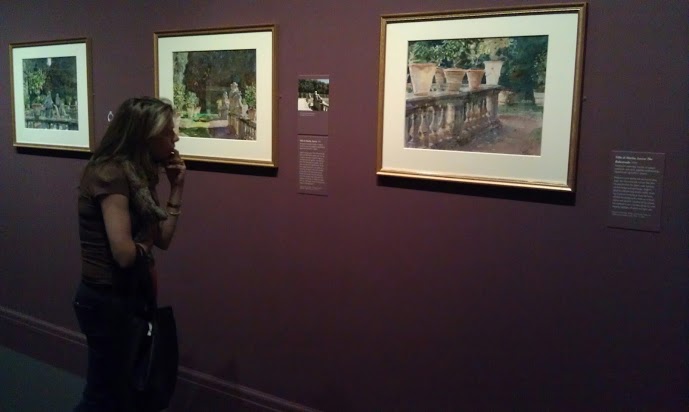 watercolours in Boston in 1908 was so well received that the MFA bought the whole show! Spurred on by this he continued to paint them with enthusiasm. In this show we see many from that first 1908 exhibition but also many from later tours. There is even an example from his paintings of the English troops ('Tommies') during the First World War - he was employed by British War Office to record scenes of combat. Seeing this reminded me of a visit to the Imperial War Museum in London where, hanging on the wall close to guns, Spitfires and Hurricanes on display there is a huge oil painting, (8ft x 20ft) of gassed and blinded troops being lead, hand in hand in a line, from the field of combat.
watercolours in Boston in 1908 was so well received that the MFA bought the whole show! Spurred on by this he continued to paint them with enthusiasm. In this show we see many from that first 1908 exhibition but also many from later tours. There is even an example from his paintings of the English troops ('Tommies') during the First World War - he was employed by British War Office to record scenes of combat. Seeing this reminded me of a visit to the Imperial War Museum in London where, hanging on the wall close to guns, Spitfires and Hurricanes on display there is a huge oil painting, (8ft x 20ft) of gassed and blinded troops being lead, hand in hand in a line, from the field of combat.
At this exhibition we were allowed, in accordance with the modern trend in exhibitions which is so heartening, to take photographs. Below I show the photos I took with my cell phone. I have produced a series of photos where you can see the whole painting, and then details, so you can get a sense of how he combines loose and expressive brushwork with more tightly controlled use so expertly. The details were taken separately with the phone just a few inches from the surface of the painting. I suggest that you just marvel at how the image pops out of what appears (deceptively) to be such casually applied paint.
Is My Taste in Art Reliable?...and Is Yours?
No doubt many who read this I imagine will offer a sharp No! But suppose you disagree with my judgment when I say that I think a work of art is good - can we say who is right and who is wrong? If we look to Church for guidance here it doesn't seem very helpful at first. The Church doesn't set out, to my knowledge, any hard and fast rules for what is appropriate style of imagery for our worship. This is a frustration to some, who wish that there were some so we could get rid of all the ugliness and sentimentalism. While to others it is their cue to allow just about anything into our churches and create the disaster of the last 50 years. If we lived in a time when the tradition of painting sacred art was still strong and living, then there probably wouldn't be any question in most people's minds, we would just happily and unquestioningly follow the current trend that and get on with it.
But we don't, and therefore in choosing images for the liturgy or for the 'domestic church' or prayer corner, there will be an element of personal taste involved. The fact that the Church does not stipulate a cannon of approved style leaves room both within existing traditions for personal responses and tastes, the flourishing of local variations and the possibility development of new styles that nevertheless sit within the bounds of what defines that tradition; and beyond that it also gives room for the development of styles that are so distinct that they would represent the establishment of a whole new tradition. I anticipate that any new style, perhaps one that marks our era, will start with one maverick artist who goes against the grain and who, it turns out, produces something that is recognised by those who choose art for our churches and other artists as capturing something that speaks to a particular need of the time.
This was recognised by Pius XII in Mediator Dei: 195. "Recent works of art which lend themselves to the materials of modern composition, should not be universally despised and rejected through prejudice. Modern art should be given free scope in the due and reverent service of the church and the sacred rites, provided that they preserve a correct balance between styles tending neither to extreme realism nor to excessive "symbolism," and that the needs of the Christian community are taken into consideration rather than the particular taste or talent of the individual artist. Thus modern art will be able to join its voice to that wonderful choir of praise to which have contributed, in honor of the Catholic faith, the greatest artists throughout the centuries. Nevertheless, in keeping with the duty of Our office, We cannot help deploring and condemning those works of art, recently introduced by some, which seem to be a distortion and perversion of true art and which at times openly shock Christian taste, modesty and devotion, and shamefully offend the true religious sense. These must be entirely excluded and banished from our churches, like "anything else that is not in keeping with the sanctity of the place."
Clearly from the latter part of the quote above, he is not saying 'anything goes' either. But how can we discern the difference? Freedom can be misused and so if we are going to look outside the traditions forms, we should be cautious. For the further we stray from traditional forms, the greater the chance of us mistakenly choosing the ugly, the superficial, the sentimental and the kitsch even if we can't see it ourselves. It is always worth taking into account that none of us should trust our taste absolutely - I therefore use the principle that in choosing art for public consumption, I will not stray outside the forms of the liturgical traditions of the Church. As NLM readers will know I accept the authority of Pope Emeritus Benedict when he states that there are three - the iconographic, the gothic and the baroque 'at its best' (the 17th century and extending further for some artists). In following this guidance therefore, we should not only be careful in accepting modern forms, but also those of the High Renaissance and naturalistic tradition of the 19th century (and artists such as Bougeureaux) which he does not include in his list of liturgical forms. Nevertheless, no one can rule out all artists from any particular era for even in the worst of times, there are likely to be individuals who are inspired and worthy of attention.
Let us suppose for a moment, though, that despite all of this I am drawn to something that is non-traditional and which, I am convinced, is good, true and beautiful nevertheless. How do I know I'm right and that this is an exception to the general guidelines given above? Every single one of us must be prepared to consider the possibility that to some degree at least, the judgments we are making are flawed. How can I tell? First of all I regardless of how much I like something I do my best to avoid anything that looks, very distorted and ultra modern in style - the chances are that these are not good for prayer. Similarly even if things seem skillfully drawn, if there is a sugary sentimentalism to the image or it looks 'kitsch' then avoid it. Then I find that asking the questions such as the following will help:
Does it reflect truth? Here I am considering if the content is reflective of what I know to be true. Does it conform to the gospel account of a scene, for example?
Is this beautiful? It might seem a statement of the obvious to put this in here, but it is surprising how often I might decide that I am drawn to something which I can't actually say that I think that it is beautiful.
Would I like to spend eternity with this? I got this question from a book by the architect Christopher Alexander who found that if you asked people for their preferences based upon different ways of asking the same question you got different answers. He found that because people have differing ideas of what constitutes beauty, you get less conformity of response than if you ask people to consider the same thing but by thinking about what the properties of beauty are. I thought this one was ingenious.
Do I like it? We don't want to eliminate personal taste altogether. Once I have got past the first set of questions then while these will not infallibly lead me to what is good and true and beautiful, it will at least increase the chances. Then I will choose something that I like. The good is, after all, the desirability of being and so at some level I have to think about how desirable something is if I am considering how good it is.
Bad or good? Bougeureau, Leonardo and Botticelli from the 19th century and the Renaissance; and the 20th century artist Marc Chagall. What do you think? I'll tell you my thoughts at the bottom....


I would consider none of these true liturgical art, which may be surprising to some readers. None conform to the established norms of the iconographic, the gothic or the baroque.
Pictures of a Newly Consecrated Serbian Orthodox Cathedral in Montenegro
 Thanks to reader Walter who gave me a link through to an article in the Orthodox Arts Journal, I am able to show you some photos of a brand new cathedral. You do have to say that the Orthodox know how to do this! Construction of the cathedral in Podgorica, capital of Montenegro began in 1993 and it was consecrated earlier this month. In these photos, which come from the article referred to above, we see wonderful relief carvings in stone on the exterior and wall paintings on the interior.
Thanks to reader Walter who gave me a link through to an article in the Orthodox Arts Journal, I am able to show you some photos of a brand new cathedral. You do have to say that the Orthodox know how to do this! Construction of the cathedral in Podgorica, capital of Montenegro began in 1993 and it was consecrated earlier this month. In these photos, which come from the article referred to above, we see wonderful relief carvings in stone on the exterior and wall paintings on the interior.






Some Upcoming Speaking Engagements - Vermont, New Hampshire and NYC
For any who might be interested, I have three speaking engagements coming up in the next few weeks; in Vermont, New Hampshire and New York City. The first is at Vermont Catholic Conference which is an all-day event taking place at St Monica's Church in Barre, VT on Saturday November 2nd. The broad theme is 'Rebuild My Church', evoking the call of evangelisation of both Pope Francis and St Francis of Assisi. I will be speaking about how the style and beauty of liturgical art communicates the truths of the Faith with a special focus on the artistic liturgical traditions as described by Pope Emeritus Benedict XVI, with a particular focus on his book, the Spirit of the Liturgy. I am one of a number of speakers supporting the keynote speaker, Sheila Liaugminas, who will be speaking on the Faith and the Family in the modern world. Follow the link above for more information and to register for the conference.
The second is at St Raphael's Church in Manchester, NH on Tuesday, November 5th at 7pm. I have been asked to talk about the role of the artist in the Church today and it will involve a short presentation, about half and hour and then discussion chaired by pastor Fr Jerome. This is one of a series of three, the first is today, in which professionals discuss their work in the context of the Faith. For information follow the link here.
The third is on Saturday, November 14th, 7.30pm at the Catholic Center at New York University, 238 Thomson Street, NY, NY. This is one of a series called the Art of the Beautiful sponsored by the Thomistic Institute, which has as series of monthly lectures running through to February next year. Their promotional poster is below.





